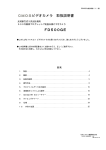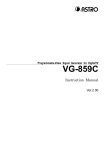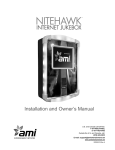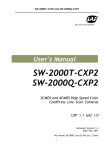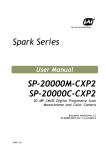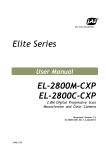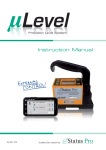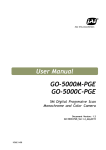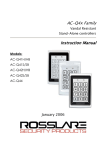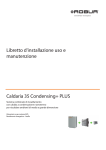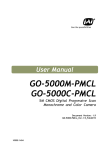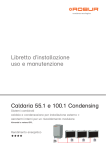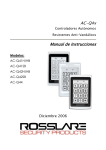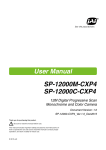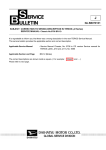Download Spark Series
Transcript
Spark Series User Manual SP-5000M-CXP2 SP-5000C-CXP2 5M Digital Progressive Scan Monochrome and Color Camera Document Version: Ver.1.7 SP-5000-CXP2_Ver.1.7_Oct2014 1044E-1304 SP-5000M-CXP2 / SP-5000C-CXP2 Notice The material contained in this manual consists of information that is proprietary to JAI Ltd., Japan and may only be used by the purchasers of the product. JAI Ltd., Japan makes no warranty for the use of its product and assumes no responsibility for any errors which may appear or for damages resulting from the use of the information contained herein. JAI Ltd., Japan reserves the right to make changes without notice. Company and product names mentioned in this manual are trademarks or registered trademarks of their respective owners. Warranty For information about the warranty, please contact your factory representative. Certifications CE compliance As defined by the Directive 2004/108/EC of the European Parliament and of the Council, EMC (Electromagnetic compatibility), JAI Ltd., Japan declares that SP-5000M-CXP2 and SP-5000CCXP2 comply with the following provisions applying to its standards. EN 61000-6-3 (Generic emission standard part 1) EN 61000-6-2 (Generic immunity standard part 1) FCC This equipment has been tested and found to comply with the limits for a Class B digital device, pursuant to Part 15 of the FCC Rules. These limits are designed to provide reasonable protection against harmful interference in a residential installation. This equipment generates, uses and can radiate radio frequency energy and, if not installed and used in accordance with the instructions, may cause harmful interference to radio communications. However, there is no guarantee that interference will not occur in a particular installation. If this equipment does cause harmful interference to radio or television reception, which can be determined by turning the equipment off and on, the user is encouraged to try to correct the interference by one or more of the following measures: - Reorient or relocate the receiving antenna. - Increase the separation between the equipment and receiver. - Connect the equipment into an outlet on a circuit different from that to which the receiver is connected. - Consult the dealer or an experienced radio/TV technician for help. Warning Changes or modifications to this unit not expressly approved by the party responsible for FCC compliance could void the user’s authority to operate the equipment. -2- SP-5000M-CXP2 Supplement The following statement is related to the regulation on “ Measures for the Administration of the control of Pollution by Electronic Information Products “ , known as “ China RoHS “. The table shows contained Hazardous Substances in this camera. mark shows that the environment-friendly use period of contained Hazardous Substances is 15 years. 嶷勣廣吭並㍻ 嗤蕎嗤墾麗嵎賜圷殆兆各式根楚燕 功象嶄鯖繁酎慌才忽佚連恢匍何〆窮徨佚連恢瞳麟半陣崙砿尖一隈〇云恢瞳ゞ 嗤蕎嗤 墾麗嵎賜圷殆兆各式根楚燕 〃泌和 桟隠聞喘豚㍉ 窮徨佚連恢瞳嶄根嗤議嗤蕎嗤墾麗嵎賜圷殆壓屎械聞喘議訳周和音氏窟伏翌 亶賜融延、窮徨佚連恢瞳喘薩聞喘乎窮徨佚連恢瞳音氏斤桟廠夛撹冢嶷麟半 賜斤児繁附、夏恢夛撹冢嶷鱒墾議豚㍉。 方忖仝15々葎豚㍉15定。 SP-5000C-CXP2 Supplement The following statement is related to the regulation on “ Measures for the Administration of the control of Pollution by Electronic Information Products “ , known as “ China RoHS “. The table shows contained Hazardous Substances in this camera. mark shows that the environment-friendly use period of contained Hazardous Substances is 15 years. 嶷勣廣吭並㍻ 嗤蕎嗤墾麗嵎賜圷殆兆各式根楚燕 功象嶄鯖繁酎慌才忽佚連恢匍何〆窮徨佚連恢瞳麟半陣崙砿尖一隈〇云恢瞳ゞ 嗤蕎嗤 墾麗嵎賜圷殆兆各式根楚燕 〃泌和 桟隠聞喘豚㍉ 窮徨佚連恢瞳嶄根嗤議嗤蕎嗤墾麗嵎賜圷殆壓屎械聞喘議訳周和音氏窟伏翌 亶賜融延、窮徨佚連恢瞳喘薩聞喘乎窮徨佚連恢瞳音氏斤桟廠夛撹冢嶷麟半 賜斤児繁附、夏恢夛撹冢嶷鱒墾議豚㍉。 方忖仝15々葎豚㍉15定。 SP-5000M-CXP2 / SP-5000C-CXP2 - Contents Introduction .....................................................................................1. General .....................................................................................2. Camera composition ....................................................................3. Main features ............................................................................4. Locations and functions ...............................................................4.1 4.2 67789- Locations and functions ............................................................................. - 9 Rear panel ............................................................................................- 10 - 5. Input and output.......................................................................... - 11 5.1 CoaXpress interface ................................................................................- 11 5.1.1 CoaXPress interface standard ................................................................- 11 5.1.2 CoaXpress interface used in SP-5000-CXP2 ................................................- 11 5.1.3 The relationship between sensor bit, pixel clock and output format. ...............- 13 5.1.4 Associated GenICam register ................................................................- 13 5.2 Connectors and pin assignment...................................................................- 14 5.2.1 Digital Video Output (75Ω 1.0・2.3 DIN Receptacle) ..................................- 14 5.2.2 12-Pin connector ..............................................................................- 14 5.2.3 AUX Standard Hirose 10-Pin connector ................................................- 15 5.2.3.1 Figure and pin configuration............................................................- 15 5.2.4 AUX Type 2 HIROSE 10-Pin connector (factory option) ..................................- 15 5.2.5 AUX Type 3 HIROSE 10-Pin connector (factory option) ................................- 16 5.3 Digital IN/OUT interface ...........................................................................- 16 5.3.1 Line Selector ....................................................................................- 16 5.3.2 Line Source......................................................................................- 17 5.3.3 Line Mode .......................................................................................- 17 5.3.4 Line Inverter ....................................................................................- 17 5.3.5 Line Status ......................................................................................- 17 5.3.6 Line Format .....................................................................................- 17 5.3.7 GPIO ..............................................................................................- 17 5.3.7.1 Basic block diagram ......................................................................- 18 5.3.7.2 IN and OUT matrix table.................................................................- 19 5.3.8 Associated GenIcam register .................................................................- 20 5.4 Pulse Generator .....................................................................................- 20 5.4.1 Clock Pre-scaler ................................................................................- 21 5.4.2 Pulse Generator Selector .....................................................................- 21 5.4.3 Pulse Generator Length .......................................................................- 22 5.4.4 Pulse Generator Start Point ..................................................................- 22 5.4.5 Pulse Generator End Point ...................................................................- 22 5.4.6 Pulse Generator Repeat Count ..............................................................- 22 5.4.7 Pulse Generator Clear Activation ...........................................................- 22 5.4.8 Pulse Generator Clear Sync Mode ...........................................................- 22 5.4.9 Pulse Generator Clear Source................................................................- 24 5.4.10 Pulse Generator Inverter ....................................................................- 25 5.4.11 Pulse Generator Setting Parameters ......................................................- 25 5.4.12 Associated GenICam register ...............................................................- 26 - 6.1 Sensor layout ........................................................................................- 27 6.1.1 Monochrome sensor............................................................................- 27 6.1.2 Bayer color sensor ............................................................................- 27 6.2. Camera output format ............................................................................- 28 6.2.1 1X-1Y .............................................................................................- 28 - 6. Sensor layout, output format and timing ........................................ - 27 - -3- SP-5000M-CXP2 / SP-5000C-CXP2 6.3 Output timing ....................................................................................... - 29 6.3.1 Horizontal timing .............................................................................. - 29 6.3.1.1 Vertical Binning OFF ..................................................................... - 29 6.3.1.2 Vertical Binning ON ...................................................................... - 29 6.3.2 Vertical timing ................................................................................. - 30 6.3.2.1 Vertical Binning OFF ..................................................................... - 30 6.3.2.2 Vertical Binning ON ...................................................................... - 30 6.3.3 ROI (Region Of Interest) setting ............................................................. - 31 6.4 Digital output Bit allocation .................................................................... - 31 - 7.1. Acquisition control (change the frame rate) .................................................. - 32 7.1.1 Acquisition frame rate ........................................................................ - 32 7.1.2 Calculation of frame rate .................................................................... - 32 7.2. Exposure setting ................................................................................... - 34 7.2.1 Exposure Mode ................................................................................. - 34 7.2.2 Exposure Time.................................................................................. - 35 7.2.3 Exposure Auto .................................................................................. - 36 7.3. Trigger Control ..................................................................................... - 36 7.3.1 Trigger Source .................................................................................. - 36 7.3.2 Trigger activation .............................................................................. - 36 7.3.3 Trigger Overlap ................................................................................. - 37 7.3.4 Associated GenICam register ................................................................ - 37 7.4. Normal continuous operation (Timed Exposure Mode/Trigger Mode OFF) ............... - 38 7.5. Timed mode ........................................................................................ - 38 7.5.1 If the overlap setting is “OFF” .............................................................. - 38 7.5.2 If the overlap setting is “Readout” ......................................................... - 39 7.6. Trigger width mode ................................................................................ - 40 7.6.1 If the overlap setting is “OFF” .............................................................. - 40 7.6.2 If the overlap setting is “Readout” ......................................................... - 41 7.7. RCT mode ........................................................................................... - 42 7.8. PIV (Particle Image Velocimetry) ................................................................ - 43 7.9. Sequence Mode ..................................................................................... - 44 7.9.1 Video send mode............................................................................... - 44 7.9.2 Sequence mode basic timing ................................................................ - 44 7.9.3 Sequence ROI setting parameters .......................................................... - 45 7.9.3.1 Sequence index table (Default) ........................................................ - 45 7.9.3.2 Descriptions of index table parameters .............................................. - 45 7.9.4 Associated GenICam register ................................................................ - 47 7.10 Multi ROI function ................................................................................. - 48 7.10.1 Multi ROI setting parameters ............................................................... - 48 7.10.2 Associated GenICam register ............................................................... - 50 7.11. Operation and function matrix ................................................................. - 50 - 8.1 Black level control .................................................................................. - 51 8.1.1 Black Level Selector........................................................................... - 51 8.1.2 Black Level...................................................................................... - 51 8.1.3 Associated GenICam register ................................................................ - 51 8.2 Gain control.......................................................................................... - 51 8.2.1 Gain Selector ................................................................................... - 52 8.2.2 Gain .............................................................................................. - 52 8.2.3 Gain Raw ........................................................................................ - 52 8.2.4 Gain Auto........................................................................................ - 52 8.2.5 Balance White Auto ........................................................................... - 53 - 7. 8. Operating modes ...................................................................... - 32 - Other functions ........................................................................ - 51 - -4- SP-5000M-CXP2 / SP-5000C-CXP2 8.2.6 Associated GenICam register ................................................................- 53 8.3. LUT ...................................................................................................- 54 8.3.1 LUT Mode ........................................................................................- 54 8.3.2 LUT Index........................................................................................- 55 8.3.3 LUT value ........................................................................................- 55 8.3.4 Associated genICam register .................................................................- 55 8.4. Gamma ...............................................................................................- 56 8.4.1 Linear and Dark Compression ................................................................- 56 8.5. Shading Correction .................................................................................- 56 8.6. Blemish compensation ............................................................................- 58 8.7. Bayer color interpolation (Only for SP-5000C-CXP2) .........................................- 59 8.8 Lens control ..........................................................................................- 59 8.8.1 About P-Iris .....................................................................................- 60 8.8.2 Setting for P-iris lens being used ............................................................- 60 8.8.2.1 P-Iris lens select ..........................................................................- 60 8.8.2.2 Step max. ..................................................................................- 60 8.8.2.3 Position .....................................................................................- 60 8.8.2.4 Current F value ...........................................................................- 60 8.8.2.5 P-Iris Auto min. / P-Iris Auto max. .....................................................- 60 8.8.3 Motorized lenses ...............................................................................- 61 8.7.3.1 Iris ...........................................................................................- 61 8.8.3.2 Zoom ........................................................................................- 61 8.8.3.3 Focus+ ......................................................................................- 61 8.8.4 Associated GenICam register ................................................................- 62 8.9 ALC ....................................................................................................- 63 8.10 HDR (High Dynamic Range) (SP-5000M-CXP2 only) ...........................................- 65 9. - Camera setting......................................................................... - 67 - 9.1 9.2 Camera Control Tool ................................................................................- 67 Camera Default settings ...........................................................................- 67 - 10. 11. External appearance and dimensions .......................................... - 68 Specifications ........................................................................ - 69 - 11.1 11.2 Spectral response ..................................................................................- 69 Specifications table ...............................................................................- 70 - Appendix ...................................................................................... - 73 1. 2. 3. 4. 5. 6. Precautions..............................................................................................- 73 Typical Sensor Characteristics .......................................................................- 73 Caution when mounting a lens on the camera ....................................................- 73 Caution when mounting the camera ................................................................- 73 Exportation .............................................................................................- 74 References ..............................................................................................- 74 - Manual change history ...................................................................... - 75 User's Record ................................................................................. - 76 - -5- SP-5000M-CXP2 / SP-5000C-CXP2 Introduction EMVA 1288 With regard to signal to noise ratio in this manual, specifications measured by EMVA 1288 are used together with specifications by a traditional measurement method. EMVA 1288 is a more complete measurement that considers multiple noise sources, including random noise, pattern noise, and shading. Additionally, EMVA 1288 incorporates temporal variances in pixel output by capturing 100 frames of data and computing the RMS variations over the captured frames. Because of the comprehensive nature of the noise analysis and the additional consideration for RMS variances over time, EMVA 1288 SNR measurements are inherently lower than the traditional SNR measurements given by manufacturers. However, the comprehensive nature combined with rigid test parameters, means that all manufacturers’ are measuring their products equally and EMVA 1288 tested parameters can be compared among different manufacturers’ products. In order to learn more about EMVA 1288, please visit http://www.emva.org Interface The SP-5000M-CXP2 and SP-5000C-CXP2 employ CoaXPress as an interface system. In order to connect the camera to a PC, it requires the use of a Frame Graber board and the appropriate coaxial cable(s). The maximum video transfer rate per coaxial cable is 6.25 Gbps. In addition to video information, power and control signals can be transferred to the camera over this interface. For detailed specifications, please refer to “JIIA-NTF-001-2010” published by Japan Industrial Imaging Association, http://www.jiia.org. Computer used for SP-5000 series In order to get proper performance from this camera, it is necessary to use a PC equipped with a PCIe 2.0 slot with a size and capacity of 16 lanes or higher (x16 or x32). Frame grabber boards used with SP-5000 series As the SP-5000M-CXP2 and SP-5000C-CXP2 employ CoaXPress as an interface system, a CoaXPresscompliant frame grabber board is required. Both cameras have two CoaXPress interface connectors and it is recommended that a frame grabber board with at least two interface connectors be used in order to maximize camera performance. Cables used with SP-5000 series For the CoaXPress interface, coaxial cables are used. In the SP-5000M-CXP2 and SP-5000C-CXP2, they use 75Ω 1.0/2.3 DIN receptacles (Amphenol ACX1785-ND or equivalent). The coaxial cable used to connect the camera must have a 75Ω 1.0/2.3 DIN-type plug at the camera side. An ordinary BNC cable cannot be used. -6- SP-5000M-CXP2 / SP-5000C-CXP2 1. General The SP-5000M-CXP2 and SP-5000C-CXP2 are among the first new Spark Series cameras to be introduced. They are high performance cameras with high resolution and a fast frame rate suitable for high speed machine vision applications. The SP-5000M-CXP2 is a monochrome progressive scan CMOS camera and the SP-5000C-CXP2 is the equivalent Bayer mosaic progressive scan CMOS camera. Both are equipped with a CMOS sensor offering a 1-inch optical format, a resolution of 5.24 million pixels, and a 5:4 aspect ratio. They provide 211 frames per second for continuous scanning with 2560 x 2048 full pixel resolution for both monochrome and raw Bayer output. 8-bit, 10-bit or 12-bit output can be selected for both monochrome and raw Bayer formats. The SP5000C-CXP2 is also capable of performing in-camera color interpolation at reduced frame rates. The new cameras feature a CoaXPress interface which uses coax cable with the capability of supplying power through the cable. The SP-5000M-CXP2 and SP-5000C-CXP2 use a dual coaxial cable interface. A full pixel readout, partial scan readout, or binning mode (monochrome only) can be selected depending on the application. The SP-5000M-CXP2 and SP-5000C-CXP2 have various comprehensive functions needed for automated optical inspection applications, such as solid state device inspection or material surface inspection. They incorporate video processing functions such as a look-up table, shading compensation and blemish compensation in addition to fundamental functions such as trigger, exposure setting and video level control. As a common Spark Series feature, a new connector for lens control is employed. SP-5000M-CXP2 and SP-5000C-CXP2 support P-iris and motor-driven lenses as standard lens control capabilities. Factory options are available to configure this connector to support DC iris systems, as well as provide a video iris output signal, or to provide additional TTL IN and OUT lines. The latest version of this manual can be downloaded from: www.jai.com The latest version of the Camera Control Tool for the SP-5000M-CXP2 and SP-5000C-CXP2 can be downloaded from: www.jai.com For camera revision history, please contact your local JAI distributor. 2. Camera composition The standard camera composition Camera body Sensor protection cap Dear Customer (sheet) is as follows. 1 1 1 The following optional accessories are available. Tripod base Power supply unit MP-42 PD-12 series -7- SP-5000M-CXP2 / SP-5000C-CXP2 3. Main features New Spark Series, 1” progressive scan camera Intelligent body design for easy and flexible installation Utilizes new CoaXPress interface using two coaxial cables Aspect ratio 5:4, 2560(H) x 2048(V) - 5.2 million effective pixels 5 μm square pixels S/N 55 dB for monochrome and 53 dB for color 8-bit, 10-bit or 12-bit output for monochrome and Bayer 3 x 8-bit output for RGB interpolated color 211 frames/second with full resolution in continuous operation (CXP-6x2) Various readout modes, including horizontal and vertical binning (SP-5000M-CXP2 only) and ROI (Region Of Interest) for faster frame rates 0 dB to +24 dB gain control for both SP-5000M-CXP2 and SP-5000C-CXP2 10 μs (1/100,000) to 8 seconds exposure control in 1 μs step Auto exposure control Timed and trigger width exposure control RCT and PIV trigger modes for specific applications ALC control with combined function of AGC, auto exposure and auto iris HDR (High Dynamic Range) function is available (SP-5000M-CXP2 only) Various pre-processing circuits are provided Programmable LUT Gamma correction from 0.45 to 1.0 Shading correction Bayer white balance with manual or one-push auto (SP-5000C-CXP2 only) Blemish compensation New Hirose 10P connector for lens interface including P-Iris lens control C-mount for lens mount Setup by Windows XP/Vista/7/8 via serial communication -8- SP-5000M-CXP2 / SP-5000C-CXP2 4. Locations and functions 4.1 Locations and functions Lens mount 10-pin connector LED 12-pin connector LINK 1 LINK 2 CXP#2 CXP#1 Mounting holes C-mount (Note *1) AUX Connector for lens control (Standard) Indication for power and trigger input DC and trigger input LINK Status indication for CXP#1 LINK Status indication for CXP#2 CoaXPress No.2 connector CoaXPress No.1 connector (Note*2) Holes for mounting tripod base or direct installation. Depth 5 mm (Note*3) *1) Note1: Rear protrusion on C-mount lens must be less than 10.0 mm. *2) Note2: When one coaxial cable is used, CXP#1 must be used. *3) Note3: The part number for the tripod adapter plate (with 1/4"-20 thread) is MP-42 (option). Fig. 1 Locations -9- SP-5000M-CXP2 / SP-5000C-CXP2 4.2 Rear panel The rear panel mounted LEDs provide the following information: POWER/TRIG Amber: Power connected – initiating This light goes OFF after initiating. Steady green: Camera is operating in Continuous mode Flashing green: The camera is receiving external triggering Note: The interval of flashing does not correspond with external trigger duration. Fig. 2 LINK1 Flashing green: Searching LINK (in case of using PoCXP) Flashing amber: Searching LINK (in case of PoCXP not being used) LINK2 Flashing amber: Searching LINK (in case of PoCXP not being used) - 10 - Rear panel SP-5000M-CXP2 / SP-5000C-CXP2 5. Input and output 5.1 5.1.1 CoaXpress interface CoaXPress interface standard The SP-5000M-CXP2 and SP-5000C-CXP2 use CoaXPress as their interface. CoaXPress is a PLUGAND-PLAY interface and connects the camera and the frame grabber board by coaxial cable(s). Its maximum transfer rate is 6.25 Gbps per one coaxial cable. Additionally, CoaXPress interface supports power supplied through the coaxial cable as well as communication signals. In the CoaXPress interface, multiple coaxial cables can be used in order to achieve a faster transfer rate or a reduced transfer rate can be used to extend the cable length. In the SP-5000M-CXP2 and SP-5000C-CXP2, a 2 coaxial cable system is used. Master Link Data/Trigger/GPIO/Control Trigger/GPIO/Control Power Camera Frame Grabber Board Extension Link Fig.3 CoaXPress interface The distance between camera and frame grabber board depends on the bit rate of the video and the cable used. Among the unique features of CoaXPress is its ability to supply DC power and provide trigger timing accuracy. The maximum power supply per one cable is 13W with DC+24V voltage. If the system uses 2 cables, it will be 26W. The accuracy of the trigger is ±2 ns at 3.125 Gbps. The CoaXPress compliance labeling is assigned to the following five cable types and the maximum bit rate and transmission length is indicated in the table below. Table -1 Compliance labeling Compliance Labeling Maximum Operational Bit Rate per coax (Gbps) and transmission length CXP-1 1.250 (up to 212 m) CXP-2 2.500 (up to 185 m) CXP-3 3.125 (up to 169 m) CXP-5 5.000 (up to 102 m) CXP-6 6.250 (up to 68 m) In the SP-5000M-CXP2 and SP-5000C-CXP2, the maximum bit rate is 6.25 Gbps per one cable and the power supply is available on the CXP#1 connector only. For the details of the specifications, please refer to “JIIA-NTF-001-2010” published by Japan Industrial Imaging Association, http://www.jiia.org. 5.1.2 CoaXpress interface used in SP-5000-CXP2 SP-5000-CXP2 utilizes the following CoaXpress interface and the following table exhibits frames rate for different output format. Number of lines: 1 or 2 lines PoCXP is available in Line 1 only. - 11 - SP-5000M-CXP2 / SP-5000C-CXP2 Pixel format in CoaXPress can be set to either 8-bit or 10-bit output. However, as shown in the chart below, the 10-bit CoaXPress pixel format is not available (x) if the sensor is set to 10-bit pixel format. Sensor Pixel Format Sensor 8bit Sensor 10bit Sensor 12bit CXP 8bit ○ ○ ○ CXP 10bit ✕ ○ ○ CXP 12bit ✕ ✕ ○ JAI recommends the following settings depending on applications. If the objective is to maximize the frame rate: The sensor pixel format should be set to a smaller value. If picture quality is the first priority: The sensor pixel format should be set larger than that of the CXP pixel format. Example: Sensor format is 12-bit and CXP format is 8-bit The relationship between pixel format and maximum frame rate is determined as described in the following table. Table – 2(1) Link Configurati on CoaxPress Interface (For Mono and Bayer) Numb PoCX Sensor8 Sensor10 Senso10 er of P bit bit bit lanes (Not CXP8bit CXP8bit CXP10bi e) t CXP-3x1 1 CXP# 53fps 42fps 42fps 1 CXP-3x2 2 CXP# 1 106fps 84fps 84fps CXP6x1 1 CXP# 1 CXP6x2 2 CXP# 211fps 169fps 166fps 1 Note: PoCXP is only available on CXP#1 connector. Table – 2(2) Sensor12 bit CXP8bit Sensor12 bit CXP10bit Sensor12 bit CXP12bit 35fps 35fps 35fps 70fps 70fps 70fps 141fps 141fps 141fps CoaxPress Interface (For RGB 8-bit) Link Number PoCXP Sensor8bit Sensor10bit Configuration of lanes (Note) CXP8bit CXP8bit CXP-3x1 1 CXP-3x2 2 CXP6x1 1 CXP6x2 2 Note: PoCXP is only CXP#1 11fps 8fps CXP#1 22fps 17fps CXP#1 CXP#1 44fps 35fps available on CXP#1 connector. - 12 - Sensor12bit CXP8bit 7fps 14fps 29fps SP-5000M-CXP2 / SP-5000C-CXP2 5.1.3 The relationship between sensor bit, pixel clock and output format. In the SP-5000-CXP2, there are three sensor bit depths available as well as three pixel clocks,72MHz, 57.6 MHz and 48 MHz. The combination of these settings is directly related to which Link Configuration can be used. The following table shows the available combinations. Table – 3 Sensor bit, Pixel clock and output format relationship Sensor bit Pixel clock Available Link Configuration Mono Bayer RGB CXP-3x1/8bit ○ ○ ○ 8bit 72MHz CXP-6x1/CXP-3x2/8bit ○ ○ ○ CXP-6x2/8bit ○ ○ ○ CXP-3x1/8bit ○ ○ ○ CXP-3x1/10bit ○ ○ CXP-6x1/CXP-3x2/8bit ○ ○ ○ 10bit 57.6MHz CXP-6x1/CXP-3x2/10bit ○ ○ CXP-6x2/8bit ○ ○ ○ CXP-6x2/10bit ○ ○ CXP-3x1/8bit ○ ○ ○ CXP-3x1/10bit ○ ○ CXP-3x1/12bit ○ ○ CXP-6x1/CXP-3x2/8bit ○ ○ ○ 12bit 48MHz CXP-6x1/CXP-3x2/10bit ○ ○ CXP-6x1/CXP-3x2/12bit ○ ○ CXP-6x2/8bit ○ ○ ○ CXP-6x2/10bit ○ ○ CXP-6x2/12it ○ ○ Note1: By selecting sensor bit depth, available link configuration is determined. 5.1.4 Associated GenICam register GenICam Access Name Link Config R/W Pixel Format R/W Sensor Pixel Format R/W Values Category Single3125Gbps Single625Gbps Device Control Dual3125Gbps Dual625Gbps [Mono] Mono8 Mono10 [Color] Image Format Control BayerGB8 BayerGB10 8 Bit RGB 10bit 12bit JAI-Custom - 13 - SP-5000M-CXP2 / SP-5000C-CXP2 5.2 5.2.1 Connectors and pin assignment Digital Video Output (75Ω 1.0・2.3 DIN Receptacle) Type: CoaXPress Connector (ACX1785-ND Amphenol Connector or equivalent) CXP#1 CXP#2 PoCXP compliant Maximum Bit Rate per one coax: 6.25 Gbps Maximum Bit Rate per two coax: 12.5 Gbps Note: If one coaxial cable is used, CXP#1 must be used. 5.2.2 12-Pin connector Type: HR-10A-10R-12PB(72) Hirose male or equivalent. Fig.4 12-pin connector Table – 4 Pin no. 1 2 3 4 5 6 7 8 9 10 11 12 Hirose 12P pin assignment Signal Remarks GND +12V to +24V DC input GND NC Opto inLine5 Opto in+ Opto outLine2 Opto out+ TTL out Line 1 (Note*1) TTL in Line 4 (Note*2) DC input +12V to +24V GND *1) Factory default setting is an Exposure Active signal with negative polarity. *2) Factory default setting is a trigger input - 14 - SP-5000M-CXP2 / SP-5000C-CXP2 5.2.3 AUX Standard Hirose 10-Pin connector 5.2.3.1 Figure and pin configuration Type : HIROSE 10-Pin Connector 3260-10S3(55) 8 1 Fig.5 Hirose 10-pin connector Table – 5 Hirose 10P pin assignment (Standard) No I/O Name Note 1 O DRIVE IRIS+ Motorized Lens 2 O DRIVE FOCUS+ Motorized Lens 3 O DRIVE ZOOM+ Motorized Lens 4 O COMMON Motorized Lens 5 GND 6 O P-IRIS OUT A+ P-Iris Lens 7 O P-IRIS OUT AP-Iris Lens 8 O P-IRIS OUT B+ P-Iris Lens 9 O P-IRIS OUT BP-Iris Lens 10 O GND 5.2.4 AUX Type 2 HIROSE 10-Pin connector (factory option) Type: HIROSE 10-Pin Connector 3260-10S3(55) Table – 6 Hirose 10P pin assignment (Option 1) No I/O Name Note 1 O Video Signal Video Iris Lens 2 O Power DC+12V Video Iris Lens 3 NC 4 NC 5 GND 6 O DC IRIS DAMPDC Iris 7 O DC IRIS DAMP+ DC Iris 8 O DC IRIS DRIVE+ DC Iris 9 O DC IRIS DRIVEDC Iris 10 GND - 15 - SP-5000M-CXP2 / SP-5000C-CXP2 5.2.5 AUX Type 3 HIROSE 10-Pin connector (factory option) Type: HIROSE 10-Pin Connector 3260-10S3(55) Table – 7 HIROSE 10P pin assignment No I/O Name 1 O TTL OUT2 2 O TTL OUT3 3 I TTL_IN2 4 NC 5 GND 6 I LVDS_IN1+ 7 I LVDS_IN18 NC 9 GND 10 GND 5.3 Note Line8 Line9 Line10 Line11 Digital IN/OUT interface In the SP-5000M-CXP2 and SP-5000C-CXP2, the digital IN/OUT capability in the software control tool can assign the necessary signals needed for the system. 5.3.1 Line Selector In the Line Selector, the following input and output signals can be assigned. Table – 8 Line selector Line Selector item Description Line 1 TTL 1 Out TTL 1 output from #9 pin of DC In/Trigger 12-Pin on the rear Line 2 Opt Out 1 Opt Out 1 output from # 7 & 8 pins of DC In/Trigger 12-Pin on the rear Line 8 TTL 2 Out TTL 2 output from #1pin “AUX” HIROSE 10-Pin on the rear (Factory option) Line 9 TTL 3 Out TTL 3 output from #2pin “AUX” HIROSE 10-Pin on the rear (Factory option) NAND 0 In 1 First input at NAND first gate in GPIO NAND 0 in 2 Second input at NAND first gate in GPIO NAND 1 In 1 First input at NAND second gate in GPIO NAND 1 in 2 Second input at NAND second gate in GPIO Note: Select and connect the line source signal against the item selected in the line selector. - 16 - SP-5000M-CXP2 / SP-5000C-CXP2 5.3.2 Line Source Line source signal can be selected from the following table to connect it to the line item which is selected in the line selector. Table - 9 Line Source Line Source item Description Low High Frame Trigger Wait Frame Active Acquisition Trigger Wait Acquisition Active Exposure Active FVAL LVAL PulseGenerator0 Out PulseGenerator1 Out PulseGenerator2 Out PulseGenerator3 Out User output 0 User output 1 User output 2 User output 3 Line 4 TTL 1 In Line 5 Opt 1 In Line 7 Trigger packet In NAND 0 Out NAND 1 Out Line 10 TTL 2 In Line 11 LVDS 1 In Connect Low Level signal to line item selected in Line Selector, Default setting Connect High Level signal to line item selected in Line Selector Connect Frame Trigger Wait signal to line item selected in Line Selector Connect Frame Active signal to line item selected in Line Selector Connect Acquisition Trigger Wait signal to line item selected in Line Selector Connect Acquisition Active signal to line item selected in Line Selector Connect Exposure Active signal to line item selected in Line Selector Connect FVAL signal to line item selected in Line Selector Connect LVAL signal to line item selected in Line Selector Connect Pulse Generator 0 signal to line item selected in Line Selector Connect Pulse Generator 1 signal to line item selected in Line Selector Connect Pulse Generator 2 signal to line item selected in Line Selector Connect Pulse Generator 3 signal to line item selected in Line Selector Connect User Output 0 signal to line item selected in Line Selector Connect User Output 1 signal to line item selected in Line Selector Connect User Output 2 signal to line item selected in Line Selector Connect User Output 3 signal to line item selected in Line Selector Connect TTL 1 In signal to line 4 in Line Selector Connect Opt 1 In signal to line 4 in Line Selector Connect CXP trigger packet IN signal to line 7 in Line Selector Connect NAND 0 signal to line item selected in Line Selector Connect NAND 1 signal to line item selected in Line Selector Connect TTL 2 In signal to Line 10 Connect LVDS 1 In signal to Line 11 Note] As for LVAL, some line items cannot be connected. Refer to “5.3.7.2 GPIO matrix table” 5.3.3 Line Mode Indicates the status of the interface, input or output. 5.3.4 Line Inverter Sets the polarity of the selected input or output. 5.3.5 Line Status Indicates the status of the selected signal, input or output (True=High or False=Low) 5.3.6 Line Format Controls the format of the line item selected in Line Selector. (No Connect, TTL, LVDS, Opt Coupled) 5.3.7 GPIO This is a general interface for input and output and controls input and output for trigger signals or valid signals and pulse generator. By using this interface, you can control an external light source, make a delayed function to input a trigger signal or make a precise exposure control with PWC trigger. - 17 - SP-5000M-CXP2 / SP-5000C-CXP2 5.3.7.1 Basic block diagram Sel Bit (5,0) Sel Bit (7) Soft Trigger LVAL IN INV Trigger 0 (Acquisition Start) Trigger 1 (Acquisition Stop) Trigger 2 (Frame Start) Trigger 3 (Transfer Start) FVAL IN Exposure Active Acquisition Trigger Wait Sel Bit (7) Acquisition Active Frame Trigger Wait Frame Active GPIO 1 (TTL OUT 1) GPIO 2 (OPT OUT 1) OPT 3 (OPT OUT 2) Time Stamp Reset GPIO 8 (TL OUT 2) GPIO 9 (TTL OUT 3) INV User output 0 INV N User output 1 User output 2 User output 3 Cross Point Switch NAND Action 1 Sel Bit (7) Action 2 INV Non INV GPIO 4 (TTL IN 1) Pulse Pulse Pulse Pulse GPIO 5 (OPT IN 1) GPIO 6 (OPT IN2) Generator Generator Generator Generator 0 1 2 3 GPIO 7 (Trigger Packet) Pulse Gnerator 20 bit counter x 4 CLR GPIO 10 (TTL IN2) GPIO 11 (LVDS IN) Pixel Clock 12 bit Counter Note1: There are three pixel clocks available. Pixel clock is related to Link Configuration. If Link Configuration is set, the appropriate pixel clock is automatically used. Note2: Items written in blue are available only if Type 3 is selected for AUX connector. Fig. 6 GPIO - 18 - SP-5000M-CXP2 / SP-5000C-CXP2 5.3.7.2 IN and OUT matrix table The following table shows the input and output matrix table. Table – 10 GPIO IN and OUT matrix table Pulse Generator Selector Frame Start Line 1 - 12P TTL Out 1 Line 2 - 12P Opt Out 1 Line 8 - TTL 2 Out Line 9 - TTL 3 Out NAND 1 In 1 NAND 1 In 2 NAND 2 In 1 NAND 2 In 2 Pulse Generator 0 Pulse Generator 1 Pulse Generator 2 Pulse Generator 3 Line Selector Acquisition Stop Source signal (Cross point switch input) LOW HIGH Line 4 - 12P TTL In Line 5 - 12P OPT In Line 7 - Trigger packet NAND 0 Out 1 NAND 1 Out 1 Pulse Generator 0 Pulse Generator 1 Pulse Generator 2 Pulse Generator 3 User Output 0 User Output 1 User Output 2 User Output 3 Software Trigger FVAL LVAL Exposure Active Acquisition Trigger Wait Acquisition Active Frame Trigger Wait Frame Active Line 10 - TTL 2 In Line 11 - LVDS 1 In Trigger Selector Acquisition Start Selector (Cross point switch output) Trigger Source Line Source Extension GPIO Connection Pulse Generator Clear Source Note: As for Line 8, Line 9, Line 10 and Line 11 are available if AUX Type 3 is used for AUX connector configuration. - 19 - SP-5000M-CXP2 / SP-5000C-CXP2 5.3.8 Associated GenIcam register GenICam Name Line Selector Line Mode Line Inverter Line Status 5.4 Access Values Category R/W Line1 - TTL Out 1 CC1 Line8 – TTL Out 2(Option) Line9 - TTL Out 3(Option) Nand Gate 0 In1 Nand Gate 0 In2 Nand Gate 1 In1 Nand Gate 1 In2 Digital I/O Control Output Input Digital I/O Control R/W False True Digital I/O Control RO False True Digital I/O Control RO Line Source R/W Line Format RO Low High Acquisition Trigger Wait Acquisition Active Frame Trigger Wait Frame Active Exposure Active FVAL PG0 to 3 User out0 to 3 TTL in Opto1 in CXP in (Trigger Packet) Nand0 to 1 Line10 - TTL In 2(Option) Line11- LVDS In(Option) TTL LVDS Opto CXP Digital I/O Control Digital I/O Control Pulse Generator The SP-5000-CXP2 has a frequency divider using the pixel clock as the basic clock and four pulse generators. In each Pulse Generator, various Clear settings are connected to GPIO. The following shows Pulse Generator default settings. - 20 - SP-5000M-CXP2 / SP-5000C-CXP2 Table - 11 Pulse Generator default settings Display Name Clock Pre-scaler Value 1 Pulse Generator Length Start Point End Repeat Clear Clear Clear Clear Pulse Generator Point Count Source Inverter Activation Sync Selector Mode 1 0 1 0 Off True Off Async Mode - Pulse Generator 0 - Pulse Generator 1 1 0 1 0 Off True Off Async Mode 1 0 1 0 Off True Off Async Mode - Pulse Generator 2 - Pulse Generator 3 1 0 1 0 Off True Off Async Mode Note: When Pulse Generator Repeat Count is set to “0”, the camera is operating in Free Running mode. However, based on the above default setting, Length=1, Start Point=0 and End Point=1, Pulse Generator stops at High output. Therefore, if Start Point=0 and End Point=1 are configured, Length should be “2” as the minimum active width. 5.4.1 Clock Pre-scaler Clock pre-scaler (Divide Value) can set the dividing value of the frequency divider (12-bit length) and the pixel clock is used for this. Four built-in pulse generators work by the same clock. In the SP-5000-CXP2, the default pixel clock is set at 48MHz. 5.4.2 Pulse Generator Selector This is where you select one of the 4 pulse generators in order to set or modify its parameters. Table - 12 Pulse Generator setting Trigger Selector Description item Pulse Generator 0 Pulse Generator 1 Pulse Generator 2 Pulse Generator 3 If Pulse Generator 0 is selected, Length Start Point、End Point、Repeat Count、Clear Source、Clear Inverter Clear Activation and Clear Sync Mode of pulse generator 0 are displayed under the selector. If Pulse Generator 1 is selected, Length Start Point、End Point、Repeat Count、Clear Source、Clear Inverter Clear Activation and Clear Sync Mode of pulse generator 1 are displayed under the selector. If Pulse Generator 2 is selected, Length Start Point、End Point、Repeat Count、Clear Source、Clear Inverter Clear Activation and Clear Sync Mode of pulse generator 2 are displayed under the selector. If Pulse Generator 3 is selected, Length Start Point、End Point、Repeat Count、Clear Source、Clear Inverter Clear Activation and Clear Sync Mode of pulse generator 3 are displayed under the selector. - 21 - SP-5000M-CXP2 / SP-5000C-CXP2 Pulse generator Clear source IN (Clear activation = Rising edge Clear SYNC mode = Async) Pulse generator repeat count = N (Pulse generator length x N) Pulse generator length Pulse generator length Pulse generator length Pulse generator Output 0 0 0 Pulse generator End point Pulse generator Start point 5.4.3 Fig.7 Pulse Generator Length Pulse Generator Pulse construction Set the counter up value (number of clocks, refer to Table 14) for the selected pulse generator. If Repeat Count value is “0”, and if Pulse Generator Clear signal is not input, the pulse generator generates the pulse repeatedly until reaching this counter up value. 5.4.4 Pulse Generator Start Point Set the active output start count value for the selected pulse generator. However, please note that a maximum 1 clock jitter for the clock which is divided in the clock pre-scaler can occur. 5.4.5 Pulse Generator End Point Set the active output ending count value for the selected pulse generator. 5.4.6 Pulse Generator Repeat Count Set the repeating number of the pulse for the selected pulse generator. After Trigger Clear signal is input, the pulse generator starts the count set in Repeat Count. Accordingly, an active pulse which has a start point and end point can be output repeatedly. However, if Repeat Count is set to“0”, it works as a Free-Running counter. 5.4.7 Pulse Generator Clear Activation Set the clear conditions of clear count pulse for the selected pulse generator. 5.4.8 Pulse Generator Clear Sync Mode Set the count clear method for the selected pulse generator. In the case of Async Mode, if the clear signal is input during the length setting value, the counter will stop counting according to the clear signal input. In the case of Sync Mode, if the clear signal is input during the length setting value, the counter will continue to count until the end of the length setting value and then clear the count. Both modes clear the repeat count when the counter is cleared. - 22 - SP-5000M-CXP2 / SP-5000C-CXP2 (Example 1) Clear Activation = Rising Edge, Clear Sync Mode = Async Mode, Clear Inverter = False Pulse Generator Clear Source In Pulse Generator Output Clear ↓ 0 Fig.8 Counter clear in Async mode (Example 2) Clear Activation = Rising Edge, Clear Sync Mode = Sync Mode, Clear Inverter = False Pulse Generator Clear Source In Pulse Generator Output Clear ↓ 0 Pulse Generator Length 0 Fig.9 Note: Repeat Count is also reset. Counter clear in Sync mode - 23 - SP-5000M-CXP2 / SP-5000C-CXP2 5.4.9 Pulse Generator Clear Source The following clear source can be selected as the pulse generator clear signal. Table - 13 Pulse generator clear source Pulse Generator Clear Source item Low High Frame Trigger Wait Frame Active Exposure Active Acquisition Trigger wait Acquisition Active FVAL LVAL PulseGenerator0 Out PulseGenerator1 Out PulseGenerator2 Out PulseGenerator3 Out User output0 Out User output1 Out User output2 Out User output3 Out TTL 1 In OPT 1 in Trigger packet In Nand 0 Out Nand 1 Out Description Connect Low level signal to Clear Source for the selected pulse generator. Default setting Connect High level signal to Clear Source for the selected pulse generator. Connect Frame Trigger Wait signal to Clear Source for the selected pulse generator. Connect Frame Active signal to Clear Source for the selected pulse generator. Connect Exposure Active signal to Clear Source for the selected pulse generator. Connect Acquisition Trigger Wait signal to Clear Source for the selected pulse generator. Connect Acquisition Active signal to Clear Source for the selected pulse generator. Connect FVAL signal to Clear Source for the selected pulse generator. Connect LVAL signal to Clear Source for the selected pulse generator. Connect Pulse Generator 0 output to Clear Source for the selected pulse generator. Connect Pulse Generator 1 output to Clear Source for the selected pulse generator. Connect Pulse Generator 2 output to Clear Source for the selected pulse generator. Connect Pulse Generator 3 output to Clear Source for the selected pulse generator. Connect User output 0 to Clear Source for the selected pulse generator. Connect User output 1 to Clear Source for the selected pulse generator. Connect User output 2 to Clear Source for the selected pulse generator. Connect User output 3 to Clear Source for the selected pulse generator. Connect TTL 1 In signal to Clear Source for the selected pulse generator. Connect Opt 1 In signal to Clear Source for the selected pulse generator. Connect Trigger packet In signal to Clear Source for the selected pulse generator. Connect NAND 0 output signal to Clear Source for the selected pulse generator. Connect NAND 1 output signal to Clear Source for the selected pulse generator. Connect TTL 2 In signal to LINE 10. Connect LVDS 1 In signal to Line 11 TTL 2 In LVDS 1 In Note: The pulse generator output cannot be used as the clear input to the same pulse generator. Refer to “5.3.6.2. Table 8 ”. - 24 - SP-5000M-CXP2 / SP-5000C-CXP2 5.4.10 Pulse Generator Inverter Clear Source Signal can be have polarity inverted. 5.4.11 Pulse Generator Setting Parameters Table - 14 Pulse Generator setting parameters Display Name Value Clock Pre-scaler Pulse Generator Clock (MHz) Pulse Generator Selector 1 to 4096 [Pixel Clock:57.6 MHz or 48 MHz]÷[Clock Pre-scaler] - Pulse Generator 0 - Pulse Generator 1 - Pulse Generator 2 - Pulse Generator 3 1 to 1048575 ([Clock Source]÷[Clock Pre-scaler])-1 x [Pulse Generator Length] [Pulse Generator Length (ms)]-1 0 to 1048574 ([Clock Source]÷[Clock Pre-scaler])-1 x [Pulse Generator Start Point] 1 to 1048575 ([Clock Source]÷[Clock Pre-scaler])-1 x [Pulse Generator End Point] [ Pulse Generator End Point (ms)]-[ Pulse Generator Start Point (ms)] 0 to 255 - Off - High Level - Low level - Rising Edge - Falling Edge - Async mode - Sync mode - Low - High - Frame Trigger Wait - Frame Active - Exposure Active - Fval - Lval - PulseGenerator0 - PulseGenerator1 - PulseGenerator2 - PulseGenerator3 - TTL_In1 - Trigger Packet_In - Nand0 Out - Nand1 Out - Line 10 - TTL 2 In - Line 11 - LVDS 1 In - False - True - Pulse Generator Length - Pulse Generator Length (ms) - Pulse Generator Frequency (Hz) - Pulse Generator Start Point - Pulse Generator Start Point (ms) - Pulse Generator End Point - Pulse Generator End Point (ms) - Pulse Generator pulse-width (ms) - Pulse Generator Repeat Count - Pulse Generator Clear Activation Clear Mode for the Pulse Generators - Pulse Generator Clear Sync Mode - Pulse Generator Clear Source - Pulse Generator Inverter(Polarity) Pulse Generator Clear Inverter Note: 1. If Pulse Generator Repeat Count is set to “0”, the pulse generator works in Free Running mode. - 25 - SP-5000M-CXP2 / SP-5000C-CXP2 5.4.12 Associated GenICam register GenICam Name Access Pre-scaler R/W Pulse Generator Selector R/W Pulse Generator Length R/W Pulse Generator Start R/W Point Pulse Generator End Point R/W Pulse Generator Count Repeat Pulse Generator Activation Clear Pulse Generator Source Clear R/W R/W R/W Pulse Generator Invertor R/W Pulse Generator Sync Mode R/W Values 1 to 4096 PG0 to PG3 0 to 1048575 Category Pulse Generators Pulse Generators Pulse Generators 0 to 1048575 Pulse Generators 0 to 1048575 Pulse Generators 0 to 255 Pulse Generators Free Run High Level Low Level Rising Edge Falling Edge Low High Soft Acquisition Trigger Wait Acquisition Active Frame Trigger Wait Frame Active Exposure Active FVAL PG0 to 3 User out0 to 3 TTL in Opto1 in CXP in (Trigger Packet) Nand0 to 1 True False Async Mode Sync Mode - 26 - Pulse Generators Pulse Generators Pulse Generators Pulse Generators SP-5000M-CXP2 / SP-5000C-CXP2 6. Sensor layout, output format and timing 6.1 Sensor layout CMOS sensors used in the SP-5000M-CXP2 and SP-5000C-CXP2 have the following tap and pixel layout. Monochrome sensor F 2048 Pixels 6.1.1 2560 Pixels Fig.10 Bayer color sensor F 2560 Pixels Pixel (0,0) Fig.11 Bayer color sensor layout - 27 - 2048 Pixels 6.1.2 Monochrome sensor layout SP-5000M-CXP2 / SP-5000C-CXP2 6.2. Camera output format The following table shows the relation between camera output and sensor readout system. Camera output format 1X–1Y Sensor readout system 1-tap readout Reference figure 6.2.1 Note: The description of camera output format is based on GenICam SFNC Ver.1.5.1. 1X-1Y 1X–1Y is defined in GenICam SFNC Ver.1.5.1 for 1-tap readout and the readout system is the following. Tap 1 Step X = 1 Pixel(0,0) X1 Y1 X2 Y1 X3 Y1 X4 Y1 X5 Y1 X6 Y1 X7 Y1 X8 Y1 X2053 Y1 X2054 Y1 X2055 Y1 X2056 Y1 X2057 Y1 X2058 Y1 X2059 Y1 X1 Y2 X5120 X2056 Y1 Y1 X2056 Y2 Height = 2048 Pixel 6.2.1 Step Y = 1 X1 Y2047 X1 Y2048 X2560 Y2047 X2 Y2048 X3 Y2048 X4 Y2048 X5 Y2048 X6 Y2048 X7 Y2048 X8 Y2048 X2553 Y2048 X2554 Y2048 X2555 Y2048 Width = 2560 Pixel Fig.12 1X – 1Y readout - 28 - X2556 Y2048 X2557 Y2048 X2558 Y2048 X2559 Y2048 X5120 X2560 Y2048 Y3840 SP-5000M-CXP2 / SP-5000C-CXP2 6.3 6.3.1 6.3.1.1 Output timing Horizontal timing Output format: 1X – 1Y 1 Clock: 13.889ns Vertical Binning OFF LVAL 1 DVAL ③ ② 1 Video Exposure Active ① Link Configuration ① (clk) Dual CXP6 12.5 Gbps Single CXP6 6.25 Gbps Dual CXP3 6.25 Gbps Single CXP3 3.125 Gbps Fig.13 6.3.1.2 165 330 330 660 ② (clk) ③ (clk) 42 207 207 537 123 123 123 123 1L (µs) 2.29 4.59 4.59 9.17 Horizontal Timing (Vertical timing OFF) Vertical Binning ON LVAL 1 DVAL ③ ② 1 Video Exposure Active ① Link Configuration ① (clk) Dual CXP6 12.5 Gbps Single CXP6 6.25 Gbps Dual CXP3 6.25 Gbps Single CXP3 3.125 Gbps Fig. 14 165 330 330 660 ② (clk) 42 207 207 537 ③ (clk) 123 123 123 123 Horizontal timing (Vertical binning ON) - 29 - 1L (µs) 2.29 4.59 4.59 9.17 SP-5000M-CXP2 / SP-5000C-CXP2 6.3.2 6.3.2.1 Vertical timing Output format: 1X – 1Y, CXP-6_2 Trigger Mode: N, Exposure Mode: Timed 1L: 165 clocks, 1 clock: 13.889 ns Vertical Binning OFF FVAL 2048L 47 ~48L(Min) DVAL CCD Exposure 9 ~10L Video Exposure Active Frame Active Fig.15 6.3.2.2 Vertical Timing (Vertical binning OFF) Vertical Binning ON FVAL 1024L DVAL CCD Exposure 9 ~10L Video Exposure Active Frame Active Fig. 16 Vertical timing (Vertical binning ON) - 30 - 47 ~48L(Min) SP-5000M-CXP2 / SP-5000C-CXP2 6.3.3 ROI (Region Of Interest) setting In the SP-5000-CXP2, a subset of the image can be output by setting Width, Height, Offset-X, and OffsetY. If the height is decreased, the number of lines read out is decreased and as the result, the frame rate is increased. However, in the horizontal direction, the horizontal frequency is not changed if the width is decreased. In the SP-5000M-CXP2, the minimum width is “64” and minimum height is “1”. In the SP5000C-CXP2, the minimum width is “64” and minimum height is “2”. Setting example (1) Binning Horizontal = 1 Binning Vertical = 1 Setting example (2) Binning Horizontal = 2 Binning Vertical = 2 Readout area OffsetX Readout area Width Width OffsetX OffsetY 2048 Height Max Height 1024 Height Max OffsetY Height 1280 Width Max 2560 Width Max Fig. 17 Digital output Fig.18 Setting example (Binning) Bit allocation CCD out Black Monochrome Color Monochrome Color 0% 8bit 8LSB Digital Out 10bit 32LSB 12bit 128LSB 100% 222LSB 890LSB 3560LSB 115% 255LSB 1023LSB 4095LSB 1023 White Clip Level 890 100% Level Digital Out [LSB] 6.4 Setting example ( No binning) 32 0 Black Level 25 Fig.19 Analog Out [mV] 700 800 Bit allocation (10-bit) - 31 - SP-5000M-CXP2 / SP-5000C-CXP2 7. 7.1. Operating modes Acquisition control (change the frame rate) 7.1.1 Acquisition frame rate With Trigger OFF (free running mode – see section 7.2.1), the default frame rate of the camera is based on the specified ROI. The smaller the ROI, the faster the default frame rate. However, it is possible to specify a free-running frame rate (i.e., no trigger needed) that is slower than the default rate. This can be useful when a longer exposure time is needed for a specific ROI. Modification of the frame rate is done by entering a value in the AcquisitionFrameRate control corresponding to frequency to be allocated to each frame period. Allowed values range from 36290 Hz to 0.125 Hz for SP-5000M-CXP2, however if the value entered is less than the time required for the default frame rate, the setting is ignored and the default frame rate is used. For example, the minimum frame period for the smallest possible ROI (1 line) requires 36290 Hz, so any entry more than 36290 will always be ignored. The setting range in Acquisition Frame Rate is: Shortest to Longest Inverse number of time required to drive all pixels to in the area set by ROI command or 0.125 Hz = 8 seconds inverse number of time required to transmit one frame data For the above setting, Acquisition Frame Rate (unit: fps or Hz) is used. Acquisition Frame Rate: 36290 Hz to 0.125 Hz How to set: ROI should be set first. The number shown in Acquisition Frame Rate will correspond to the minimum frame period for the specified ROI. The value can be decreased up to 0.125 Hz. If ROI is changed from a smaller size to a larger size, the default frame rate of the ROI is automatically recalculated inside the camera and changed to the slower frame rate of the larger ROI. 7.1.2 Calculation of frame rate The frame rate for a specific ROI is calculated using the following formula. HEIGHT and Width are the size of ROI. CEXP_B、CEXP_F、CH and FSYS are listed in the table. TEXP_B (µs) TEXP_F (µs) TROW (µs) Twait (µs) K EXR EXC = CEXP_B / FSYS = CEXP_F / FSYS = CH / FSYS = TROW x 2 = ceil(TEXP_B / TROW) + 1.0 =2 =1 - 32 - SP-5000M-CXP2 / SP-5000C-CXP2 Normal TREADOUT (µs) = TROW * (HEIGHT + K + EXR) + EXC / FSYS + TWAIT + TEXP_F Frame rate(fps) = 1/Roundup (1000000.0 * TREADOUT) PIV TREADOUT (µs) = TROW * (HEIGHT + K + EXR) + EXC / FSYS + TWAIT + TEXP_F + 0.00005 Frame rate(fps) = 1/Roundup (1000000.0 * TREADOUT) RCT TREADOUT (µs) = TROW * (HEIGHT + K + EXR) + EXC / FSYS + TWAIT + TEXP_F + 0.00005 Frame rate(fps)= 1/Roundup (1000000.0 * TREADOUT) + 158 CH CXP LINK SP-5000M_CXP2 Pixel Format 6GX2 Width>2112 SP-5000C-CXP2 Width>1984 Width<=1984 165 137 130 165 165 165 167 139 132 167 167 167 Mono12/BayerGR12 165 137 130 165 165 165 792 792 792 Mono8/BayerGR8 330 264 248 330 330 330 Mono10/BayerGR10 330 264 248 330 330 330 Mono12/BayerGR12 330 264 248 330 330 330 1584 1584 1584 Mono8/BayerGR8 330 264 248 330 330 330 Mono10/BayerGR10 330 264 248 330 330 330 Mono12/BayerGR12 330 264 248 RGB8 3GX1 Width<=1984 Mono10/BayerGR10 RGB8 3GX2 Width>1984 Mono8/BayerGR8 RGB8 6GX1 Width>2112 330 330 330 1584 1584 1584 Mono8/BayerGR8 660 528 496 660 660 660 Mono10/BayerGR10 660 528 496 660 660 660 Mono12/BayerGR12 660 528 496 RGB8 FSYS Sensor Pixel Format FSYS 8bit 72,000,000 10bit 57,600,000 12bit 48,000,000 CEXP_F Sensor Pixel Format SP-5000M_CXP2 SP-5000C-CXP2 8bit 168 168 10bit 136 136 12bit 112 112 - 33 - 660 660 660 3168 3168 3168 SP-5000M-CXP2 / SP-5000C-CXP2 CEXP_B SP-5000M_CXP2 Sensor Pixel Format Width>2112 7.2. SP-5000C-CXP2 Width>1984 Width<=1984 Width>2112 Width>1984 Width<=1984 8bit 723 735 735 723 723 723 10bit 581 589 590 581 581 581 12bit 490 490 490 490 490 490 Associated GenICam register GenICam Name Access Values Category Acquisition Frame Rate Acquisition Frame Rate Raw R/W R/W 0.125 to 211 4785 to 8000000 Acquisition Control Acquisition Control Exposure setting This section describes how to set the exposure settings. 7.2.1 Exposure Mode The exposure mode can be selected from the following three ways. Table35. Exposure mode Exposure Mode setting OFF Timed Trigger Width Exposure operation No exposure control (free-running operation) Exposure operation at the value set in Exposure Time. Setting value is usec unit. ・If Trigger Mode setting is OFF, the camera is in free-running operation. ・If Trigger Mode setting is ON, the exposure operation depends on the setting of Trigger Option. The exposure is controlled by the pulse width of the external trigger. ・Trigger Mode is forced to ON. For trigger operation, Exposure Mode must be set to something other than OFF and Trigger Mode of Frame Start must be ON. If Exposure Mode is set at Timed, the exposure operation can be selected as follows by setting Trigger Option Table36. Trigger option Trigger Option setting OFF RCT PIV RCT Continuous Exposure operation Timed (EPS) mode RCT mode, the video signal is output only if the trigger signal is inout PIV (Particle Image Velocimetry) mode RCT mode but, the video signal is also output like a free-running operation The effect of the combination of Exposure Mode, Trigger Option and Trigger Mode is as follows. - 34 - SP-5000M-CXP2 / SP-5000C-CXP2 Table37. The combination of Exposure Mode, Trigger Option and Trigger Mode Exposure Mode Trigger Option Trigger Mode (Frame Start) N/A N/A OFF OFF OFF ON Timed RCT/ RCT continuous Forced to ON PIV Forced to ON N/A Forced to ON Trigger Width Operation Self-running operation Exposure control by Exposure Time is not possible Self-running operation Exposure control by Exposure Time is not possible Timed (EPS) Operation Exposure can be controlled by Exposure Time RCT Operation Exposure can be controlled by Exposure Time PIV Operation Exposure can be controlled by Exposure Time Exposure is controlled by the pulse width of the external trigger Table 38. Associated GenICam register information 7.2.2 GenICam Name Access Exposure Mode R/W Trigger Mode R/W Trigger Option R/W Values Off Timed TriggerWidth Off On Off RCT PIV RCT Continuous Category Acquisition Control Acquisition Control JAI-Custom Exposure Time This command is effective only when Exposure Mode is set to Timed. It is for setting exposure time. The setting step for exposure time is 1 μsec per step. Minimum: 10 μsec Maximum: 8 seconds Associated GenICam register GenICam Access Name Values Category Exposure Mode R/W Off Timed Acquisition Control TriggerWidth Exposure Time R/W 10 to Acquisition Control 1000000 [us] Exposure Time Raw R/W 10 to Acquisition Control 1000000 [us] - 35 - SP-5000M-CXP2 / SP-5000C-CXP2 7.2.3 Exposure Auto This is a function to control the exposure automatically. It is effective only for Timed. JAI ALC Reference controls the brightness. There are three OFF: Once: Continuous: modes, OFF, Once and Continuous. No exposure control Exposure adjusts when the function is set, then remains at that setting Exposure continues to be adjusted automatically In this mode, the following settings are available. ALC Speed: Rate of adjustment can be set ASC Max: The maximum value for the exposure time to be controlled can be set ASCMin: The minimum value for the exposure time to be controlled can be set ALC Reference: The reference level of the exposure control can be set ALC Channel area: The measurement area of the exposure control can be set Associated GenICam register 7.3. GenICam Name Access Exposure Auto R/W Off Continuous Acquisition Control Once Exposure Auto Max R/W 100 to 1000000 JAI-Custom Exposure Auto Min R/W 100 to 1000000 JAI-Custom Values Category Trigger Control 7.3.1 Trigger Source The following signals can be used as the trigger source signal. OFF Line 5 (Input to Opt In 1 and output from Digital IO Line 4 (Input to TTL In1 and output from Digital IO User Out 0 to 3 Trigger Packet IN Soft Trigger Pulse Generator 0 to 3 NAND1/NAND2 7.3.2 Trigger activation This command can select how to activate the trigger. Rising Edge: At the rising edge of the pulse, the trigger is activated. Falling Edge: At the falling edge of the pulse, the trigger is activated. Level High: During the high level of trigger, the accumulation is activated Level Low: During the low level of trigger, the accumulation is activated If Exposure Mode is set to Trigger Width, Level High or Level Low must be used. - 36 - SP-5000M-CXP2 / SP-5000C-CXP2 Table – 16 Trigger activation for each trigger mode RisingEdge FallingEdge Timed ○ ○ TriggerWidth × × Timed - PIV ○ ○ Timed - RCT ○ ○ LevelHigh × ○ × × LevelLow × ○ × × 7.3.3 Trigger Overlap This function defines whether or not a trigger pulse can be accepted while data is being read out. OFF: The trigger pulse is not accepted during the sensor readout. Read Out: The trigger pulse can be accepted during the sensor readout. 7.3.4 Associated GenICam register GenICam Name Access Values Category Trigger Selector R/W Acquisition Start Acquisition End Frame Start Acquisition Control Trigger Mode R/W On Off Acquisition Control Command Acquisition Control Trigger Software W Trigger Source R/W Trigger Activation R/W Trigger Over Lap R/W Low High Soft Frame Trigger Wait Frame Active Exposure Active FVAL PG0 to PG3 User out0 to 3 TTL in Optp1 in CXP in (Trigger Packet) Nand0 to 1 Rising Edge Falling Edge Level High Level Low Off Read out Acquisition Control Acquisition Control Acquisition Control - 37 - SP-5000M-CXP2 / SP-5000C-CXP2 7.4. Normal continuous operation (Timed Exposure Mode/Trigger Mode OFF) This is used for applications which do not require triggering. In this mode, the video signal for the auto-iris lens is available if AUX connector is configured with option Type 2. For the video timing, refer to chapter 6.3. The frame rate of full pixels readout is 211 fps. Primary settings to use this mode Trigger Mode: Off 7.5. Timed mode This mode allows a single image frame to be captured with a preset exposure time by using the external trigger. Additional settings determine if the trigger pulse can be accepted during the exposure period. Primary settings to use this mode Exposure Mode: Timed Trigger Mode: ON 7.5.1 If the overlap setting is “OFF” t1 Trigger CMOS Exposure t2 Exposure Active Exposure Period t3 FVAL t1 2L (Min) t2 12.2 us Fig.20 T3 8L to 9L Overlap OFF - 38 - SP-5000M-CXP2 / SP-5000C-CXP2 7.5.2 If the overlap setting is “Readout” t1 Trigger CMOS Exposure t2 Exposure Active Exposure Period t3 FVAL t1 2L t2 12.2 us Fig.21 t5 8L to 9L Readout - 39 - SP-5000M-CXP2 / SP-5000C-CXP2 7.6. Trigger width mode In this mode, the exposure time is equal to the trigger pulse width. Accordingly, longer exposure times are supported. Additional settings determine if the trigger pulse can be accepted during the exposure period. Primary settings to use this mode Exposure Mode: Trigger Width Trigger Mode: ON 7.6.1 If the overlap setting is “OFF” t1 Trigger t4 t2 CMOS Exposure Exposure Active Exposure Period t3 FVAL t1 t2 10 µs + 2.7 µs(Min) 12.2 µs t3 7.5L ~8.5L t4 8.8 µs Note: In this mode, Exposure Active signal is -2.7 µs against the external trigger signal. Therefore, the external trigger signal should be +2.7 µs against the required Exposure Active signal. Fig.22 Overlap = OFF - 40 - SP-5000M-CXP2 / SP-5000C-CXP2 7.6.2 If the overlap setting is “Readout” t1 Trigger t4 t2 CMOS Exposure Exposure Active Exposure Period t3 FVAL t1 t2 t3 10 µs + 2.7 µs(Min) 12.2 µs 7.5L ~8.5L Fig.23 t4 8.8 µs Readout Note: In this mode, Exposure Active signal is -2.7µs against the external trigger signal. Therefore, the external trigger signal should be +2.7µs against the required Exposure Active signal. - 41 - SP-5000M-CXP2 / SP-5000C-CXP2 7.7. RCT mode Until the trigger is input, the camera operates continuously and the video signal for the auto-iris lens is output provided the AUX connector has been ordered with a Type 2 configuration option. At this moment, the video signal, FVAL and LVAL are output but DVAL is not output. When the trigger is input, the fast dump is activated to read out the electronic charge very quickly, after which the accumulation and the readout are performed. When the accumulated signal against the trigger is read out, FVAL, LVAL and DVAL are output too. Primary settings to use this mode Exposure Mode: Timed Trigger Mode: ON Trigger Option: RCT In this mode, the setting of Trigger Overlap is invalid. Trigger CMOS Exposure t1 Exposure Active FVAL t2 DVAL t1 56.8 µs t2 8L ~9L Fig.24 RCT mode timing - 42 - SP-5000M-CXP2 / SP-5000C-CXP2 7.8. PIV (Particle Image Velocimetry) The Particle Image Velocimetry mode can be used in applications where 2 images need to be taken with a very short time interval. It can only be used with strobe flash as illumination. The first accumulation time is 10 sec to 2 sec. Then, the second exposure will be taken. The accumulation is LVAL asynchronous. The first strobe is activated during the first exposure duration and the second strobe is pulsed while the first frame is being read out. In this way, two strobe flashes generate two video outputs. Primary Settings Exposure Mode: Timed Trigger Mode: ON Trigger Option: PIV In this mode, the setting of Trigger Overlap is invalid. Trigegr Exposure Exposure Active FVAL DVAL td time name td te1 te2 itf T tframe1 tframe2 te1 itf te2 tframe1 description Exposure beginning delay First exposure time period Second exposure time Inter framing time FVAL non active First Frame read out Second Frame read out Fig.25 PIV mode - 43 - T time 12.2µs 10μs ~ 1s 2082L 12.8μs 36 ~37 L 1 frame 1 frame tframe2 SP-5000M-CXP2 / SP-5000C-CXP2 7.9. Sequence Mode This mode allows the user to define a preset sequence of up to 10 images, each with its own ROI, exposure time and gain values. In this mode, auto functions such as AGC, ASC, AIC and AWB are not available. 7.9.1 Video send mode The sequential trigger mode is selected via the Video Send Mode command and has the following options. Video send mode Trigger Sequence How to select the index Select the index by the Frame Start trigger signal. (The setting index can be determined by the next index setting.) Select the index number to assign directly by the Command Sequence Index command. Command Sequence Video Send Mode “Normal” “Normal” “Trigger Sequence” Sequence Index Can be changed Sequence Index Cannot be changed Sequence Reset Command “Trigger Sequence” Sequence Index Can be changed Sequence Index Cannot be changed “Execute” Sequence Index Execute from Index 0 Sequence Index Pointer & Repetition Count Clear Sequen ce Index Execute from Index 0 Sequence Index Execute From Index 0 Frame Start Trigger In Frame Active Out Sequence Index Stop Fig. 26 7.9.2 Sequence Index Performing Sequence Index Stop Sequence Index Performing Behavior if Video Send Mode is set to Trigger Sequence Sequence mode basic timing In this mode, as each trigger input is received, the image data associated with the next index within the preset sequence is output. Frame Start Trigger In Sequence behavior Index 0 Index 1 Index 2 Index 3 Index 4 Frame count =1 Next Index = Index 1 Frame count =1 Next Index = Index 2 Frame count =1 Next Index = Index 3 Frame count =1 Next Index = Index 4 Frame count =1 Next Index = Index 5 Fig. 27 Behavior of Sequence trigger - 44 - SP-5000M-CXP2 / SP-5000C-CXP2 7.9.3 Sequence ROI setting parameters 7.9.3.1 Sequence index table (Default) The following table shows the default settings. Table – 17 Sequence Index table (Default) Sequence ROI Offset Width Sequence ROI Index - Index 0 - Index 1 - Index 2 - Index 3 - Index 4 - Index 5 - Index 6 - Index 7 - Index 8 - Index 9 7.9.3.2 2560 2560 2560 2560 2560 2560 2560 2560 2560 2560 Gain Selector 2048 2048 2048 2048 2048 2048 2048 2048 2048 2048 Binning X Y Gain (ALL) Red Blue Exposure Time 0 0 0 0 0 0 0 0 0 0 0 0 0 0 0 0 0 0 0 0 100 100 100 100 100 100 100 100 100 100 0 0 0 0 0 0 0 0 0 0 0 0 0 0 0 0 0 0 0 0 180000 180000 180000 180000 180000 180000 180000 180000 180000 180000 Height Black Level 0 0 0 0 0 0 0 0 0 0 Horizontal Vertical LUT Enable Frame Count 1 (Off) 1 (Off) 1 (Off) 1 (Off) 1 (Off) 1 (Off) 1 (Off) 1 (Off) 1 (Off) 1 (Off) 1 (Off) 1 (Off) 1 (Off) 1 (Off) 1 (Off) 1 (Off) 1 (Off) 1 (Off) 1 (Off) 1 (Off) Off Off Off Off Off Off Off Off Off Off 1 1 1 1 1 1 1 1 1 1 Next Index Index 0 Index 0 Index 0 Index 0 Index 0 Index 0 Index 0 Index 0 Index 0 Index 0 Descriptions of index table parameters (1) Sequence ROI Index Selector In Sequence ROI Index Selector, Index 0 to 9 can be selected. Sequence ROI – Width, Height, Offset X, Offset Y, Gain Selector - Gain/Red/Blue, Exposure Time, Black Level, Binning Horizontal, Binning Vertical, LUT Enable, Frame Count, Next Index for the selected index are displayed. (2) Sequence ROI Width Set the width of sequence ROI. The setting range is 16 to 2560 pixels. Rules for setting area and step number are the same as the normal ROI mode set by [Video Send Mode] =“Normal”. (3) Sequence ROI Height Set the height of sequence ROI. The setting range is 1 to 2048 lines. Rules for setting area and step number are the same as the normal ROI mode set by [Video Send Mode] =“Normal”. (4) Sequence ROI Offset X Set Offset X of sequence ROI. Sequence ROI Binning Horizontal = 1 (Off): Setting range is 0 to (2560 - [Sequence ROI Width]) Sequence ROI Binning Horizontal = 2 (On): Setting range is 0 to (1280 - [Sequence ROI Width]) The limitations of step number and other factors are the same as the normal ROI mode set by [Video Send Mode] =“Normal”. (5) Sequence ROI Offset Y Set Offset Y of sequence ROI. Sequence ROI Binning Vertical = 1 (Off): Setting range is 0 to (2048 - [Sequence ROI Height]) Sequence ROI Binning Vertical = 2 (On): Setting range is 0 to (1024 - [Sequence ROI Height]) The limitations of step number and other factors are the same as the normal ROI mode set by [Video Send Mode] =“Normal”. - 45 - SP-5000M-CXP2 / SP-5000C-CXP2 (6) Sequence ROI Gain Selector In Sequence ROI Gain Selector, the gain settings for each index are available. SP-5000C-CXP2: Gain (ALL), Red and Blue can be set. SP-5000M-CXP2: Only Gain is displayed and can be set. (7) Sequence ROI Black Level Black Level setting is available for each index. (8) Sequence ROI Exposure Time Exposure Time setting is available for each index. (9) Sequence ROI Binning Horizontal ON or OFF of Horizontal Binning for each index can be set. (10) Sequence ROI Binning Vertical ON or OFF of Vertical Binning for each index can be set. (11) Sequence ROI LUT Enable Enable or disable of LUT function for each index 0 to 9 can be set. (12) Sequence ROI Frame Count This can set how many times the selected index is repeated. This is applied to each index. Triggers are input according to numbers set in Frame Count and index is repeated and moves to the next index. Therefore, the same number of triggers as Frame Count must be input. (13) Sequence ROI Next Index The number of the index that will follow the current index can be set. If [Video Send Mode] is set to “Trigger Sequence” and the trigger pulse is input in EPS trigger, the sequence is executed from index 0. (14) Sequence ROI Reset Command This command resets the current index pointer and reverts to index 0 in the table. Frame Count is also re-initialized. - 46 - SP-5000M-CXP2 / SP-5000C-CXP2 7.9.4 Associated GenICam register GenICam Name Sequence ROI Index Sequence Repetition Sequence ROI Frame Count Sequence ROI Next Index Sequence ROI Width Sequence ROI Height R/W R/W Values Normal Trigger Sequence Command Sequence Multi ROI 0 to 9 0 to 255 R/W 0 to 255 JAI-Custom R/W R/W R/W JAI-Custom JAI-Custom JAI-Custom Sequence ROI OffsetX R/W Sequence ROI OffsetY R/W Sequence ROI Gain R/W Sequence Exposure Time R/W Sequence ROI H Binning Sequence ROI V Binning R/W R/W Sequence ROI LUT Enable R/W 0 to 10 0 to 2560 0 to 2048 0 to (2560 – Sequence ROI Width) 0 to (2048 – Sequence ROI Height) 100 to 1600 10 to Acquisition Frame rate Raw 1 or 2 1 or 2 Off On R/W -256 to 255 JAI-Custom R/W -4533 to 17713 JAI-Custom R/W -4533 to 17713 JAI-Custom Video Send Selector Mode Sequence ROI Black Level Sequence ROI Gain Red (for Color Model) Sequence ROI Gain Blue (for Color Model) Access R/W - 47 - Category JAI-Custom JAI-Custom JAI-Custom JAI-Custom JAI-Custom JAI-Custom JAI-Custom JAI-Custom JAI-Custom JAI-Custom SP-5000M-CXP2 / SP-5000C-CXP2 7.10 Multi ROI function This function divides one frame image into a maximum of 8 images vertically and reads out all areas in one frame. In this function, width is the same for all 8 images. The multi ROI function is enabled if [Video Sending Mode] is set to “Multi ROI”. Table - 18 Multi ROI Index table default values Multi ROI Index Max 1 Multi ROI Width 2560 Multi ROI Offset Multi ROI Index Selector - Index 1 - Index 2 - Index 3 - Index 4 - Index 5 - Index 6 - Index 7 - Index 8 7.10.1 Height 1 1 1 1 1 1 1 1 X Y 0 0 0 0 0 0 0 0 0 0 0 0 0 0 0 0 Multi ROI setting parameters (1) Multi ROI Index Max:Setting value = 1 ~ 8 Maximum 8 ROI settings are possible in a frame. Set Index 1 through 8 in Multi ROI Index table as an application requires. (2) Multi ROI Width The setting range and Step number are the same as the normal ROI setting in which [Width] plus [Offset X] should be equal to [Width Max]. In Multi ROI operation, the maximum offset value in index 1 to index 8 is the object in this calculation. (3) Multi ROI Index Selector: Index 1 to 8 can be selected. [Height], [Offset X], and [Offset Y] of the selected Multi ROI Index are displayed and can be set. (4) Multi ROI Offset X: Offset X can be set for each ROI area of Multi ROI Index 1 to 8. The restriction for setting Step and other factors are the same as the normal ROI setting. As described before, in Multi ROI operation, Multi ROI Width is a common width setting for Multi ROI Index 1 to 8. (5) Multi ROI Height: Height can be set for each ROI area of Multi ROI Index 1 to 8. The restriction for setting Step and other factors are the same as the normal ROI setting. (6) Multi ROI Offset Y: Offset Y can be set for each ROI area of Multi ROI Index 1 to 8. The restriction for setting Step and other factors is the same as the normal ROI setting. The sum of Multi ROI Height values of index 1 to 8 should be less than Height Max. - 48 - SP-5000M-CXP2 / SP-5000C-CXP2 ROI setting explanation if Multi ROI Index Max is set to 4 Index 4 Offset X Index 2 Offset X Index 1 Offset X Index 3 Offset X Index 1 Offset Y Index 1 Height Index 2 Offset Y Index 2 Height Index 3 Offset Y Index 3 Height Index 4 Offset Y Index 4 Height H-Binning Off Width Max = 2560 Video output of Multi ROI [Width]= [Multi ROI Width] ] [Height]= [Index 1 Multi ROI Height]+ [Index 2 Multi ROI Height]+ [Index 3 Multi ROI Height]+ [Index 4 Multi ROI Height] Fig. 28 Multi ROI settings and output image - 49 - V-Binning Off Height Max = 2048 SP-5000M-CXP2 / SP-5000C-CXP2 7.10.2 Associated GenICam register GenICam Name Video Send Mode Selector R/W Multi Multi Multi Multi Multi Multi R/W R/W R/W R/W R/W R/W 7.11. Table – 19 ROI Index ROI Width ROI Next Index ROI Offset X ROI Height ROI Offset Y OFF OFF Trigger Width Timed (RCT) Timed (PIV) Category Normal Trigger Sequence Command Sequence Multi ROI 1 to 8 0 to 2560 1 to 8 0 to 2560 – Multi ROI Width 0 to 2048 0 to 2048 – Multi ROI Height JAI-Custom JAI-Custom JAI-Custom JAI-Custom JAI-Custom JAI-Custom JAI-Custom Operation and function matrix Trigger mode Timed (EPS) Values Operation and function matrix Trigger Mode Timed Access OFF ON ON ON ON Auto Auto White Iris Balance Output (Note2) V. H. Trigger Binning Binning option (Note1) (Note1) Exposure Time ROI 1 1 × ○ ○ ○ ○ × × 2 2 × ○ ○ ○ ○ × × 1 1 ○ ○ ○ ○ ○ ○ × 2 2 ○ ○ ○ ○ ○ ○ × 1 1 ○ ○ ○ ○ ○ ○ ○ 2 2 ○ ○ ○ ○ ○ ○ 1 1 × ○ ○ ○ × ○ 2 2 × ○ ○ ○ × ○ 1 1 ○ ○ ○ ○ ○ ○ × 2 2 × × ○ × × × × 1 1 × ○ × × × × × 2 2 × × × × × × × OFF OFF OFF OFF RCT PIV Auto Auto gain Exposure (Note3) ○ (Note3 ○ (Note3 ○ (Note3 Note 1. Only SP-5000M-CXP2 Note 2: Only SP-5000C-CXP2 Note 3: If the trigger interval is long, iris may exhibit a hunting phenomenon. - 50 - Over Lap SP-5000M-CXP2 / SP-5000C-CXP2 8. Other functions 8.1 Black level control This function adjusts the setup level. The adjusting level is -63 to +64LSB at 10-bit output. 8.1.1 Black Level Selector The following factors can be set. SP-5000M-CXP2: DigitalAll SP-5000C-CXP2: DigitalAll/DigitalRed/ DigitalBlue 8.1.2 Black Level The black level can be set in the following range. SP-5000M-CXP2: DigitalAll:-256 ~255 SP-5000C-CXP2: DigitalAll:-256~255 DigitalRed/DigitalBlue:-512~ +511 8.1.3 Associated GenICam register GenICam Name Access Black Level Selector Black Level Raw 8.2 Values Category R/W Digital All Analog Control R/W -256 to 255 Analog Control Gain control In the SP-5000-CXP2, the gain control uses Analog Base Gain and Digital Gain. Analog Base Gain can be set at 0dB, +6dB or +12dB. The digital gain is used for the master gain setting. For setting the gain, 1. Set analog gain (Select from 0dB, +6dB and +12dB) 2. Set digital gain The master gain (DigitalAll) for both monochrome and color can be set x1(0dB) to x16(+24dB) against the analog base gain. The resolution for gain setting is 0.01%/step which is 0.05dB to 0.08dB, depending on the setting value. In the SP-5000C-CXP2, blue and red gain can be set from x0.45 to x5.62 against the master gain setting and its resolution is x0.01/step. 3. In the SP-5000C-CXP2, Analog Gain can be applied to R, G and B channel respectively in order to cover wider range of color temperature. Note1: If the gain up function is used, it is recommended to use the analog base gain as the master gain setting. For instance, if +12dB gain up is required, the analog base gain is set at +12dB and no digital gain is added. This is because the signal-to-noise is better on analog gain performance. However, the AGC function works only in digital gain. Additionally, the analog base gain is effective in order to minimize gaps in the histogram at higher gain settings. Please note that the analog base gain has less accuracy due to its variability. - 51 - SP-5000M-CXP2 / SP-5000C-CXP2 Note2: If Analog Base Gain is set at 0dB and Digital Gain is used at high gain setting, the video level may be unstable and fluctuating approx. 5%. In this case, it is suggested to set the analog base gain at +6dB or +12dB. Gain Setting Value Gain X89.12 1600 (Magnification) Master Master 39dB 24dB R&B Blue 0dB -7dB X7.15 0 Red 15dB X16 X5.62 Gain Setting Value Gain Control Range for Bayer Color Magnification 15dB 15dB 0dB X1 0dB -7dB X0.45 37846 (X5.62) 0 (X1) -4523 (X0.45) 37846 (X5.62) 0 (X1) -4523 (X0.45) -7dB The above drawing shows the relation among gain setting value (command), gain amplitude, and dB indication. For example, the gain amplitude “x 3.16” equals 10dB. Fig.29 Gain control 8.2.1 Gain Selector The following parameters can be set. SP-5000M-CXP2: DigitalAll SP-5000C-CXP2: DigitalAll/Digital Red All/Digital Blue All 8.2.2 Gain This is the reference value upon which gain adjustments are based. The operational adjustment is done in Gain Raw. SP-5000M-CXP2: DigitalAll:1~16 (0dB to +24dB) SP-5000C-CXP2: DigitalAll:1~16 (0dB to +24dB) Digital Red All:0.4466~5.6235 Digital Blue All:0.4466~5.6235 8.2.3 Gain Raw The gain raw can be adjusted in the following range. SP-5000M-CXP2: DigitalAll:100~1600 SP-5000C-CXP2: DigitalAll:100~1600 Digital Red All/Digital Blue All:-45~379 8.2.4 Gain Auto This function automatically controls the gain level. This is controlled by the command JAI ALC Reference. There are three modes. - 52 - SP-5000M-CXP2 / SP-5000C-CXP2 OFF: Adjust manually. Once: Operate only one time when this command is set Continuous: Operate the auto gain continuously The following detailed settings are also available. ALC Speed: The rate of adjustment of GainAuto can be set (Common with ExposureAuto). Gain Auto Max: The maximum value of GainAuto control range can be set Gain Auto Min: The minimum value of GainAuto control range can be set ALC Reference: The reference level of Gain Auto control can be set (Common with ExposureAuto) ALC channel area: The measurement area of GainAuto control can be set, either entire area or individual section (Common with ExposureAuto) High Mid-left High Mid-right High Right Mid-High Left Mid-High Mid-left Mid-High Mid-right Mid-High Right Mid-Low Left Mid-Low Mid-left Mid-Low Mid-right MidLow Right Low Mid-left Low Mid-right Low Right High Left Low Left Fig. 30 Channel area 8.2.5 Balance White Auto This is a function to achieve auto white balance by using R and B gain. There are three operations. OFF: Manual operation Once: Only when this operation is set, the auto white balance is executed. Continuous: The auto white balance is continuously executed. 4600K/5600K/6500K: Preset color temperature setting 8.2.6 Associated GenICam register GenICam Name Balance White Auto (for Color) Balance White Channel Area ALL Balance White Channel Area Low Right Balance White Channel Area Low Middle Right Access R/W R/W Values Off Once Continuous Preset4600K Preset5600K Preset6500K Off On Category Analog Control JAI-Custom R/W Off On JAI-Custom R/W Off On JAI-Custom - 53 - SP-5000M-CXP2 / SP-5000C-CXP2 Balance White Channel Area Low Middle Left Balance White Channel Area Low Left Balance White Channel Area Middle Low Right Balance White Channel Area Middle Low Middle Right Balance White Channel Area Middle Low Middle Left Balance White Channel Area Middle Low Left Balance White Channel Area Middle High Right Balance White Channel Area Middle High Middle Right Balance White Channel Area Middle High Middle Left Balance White Channel Area Middle High Left Balance White Channel Area High Right Balance White Channel Area High Middle Right Balance White Channel Area High Middle Left Balance White Channel Area High Left 8.3. R/W Off On JAI-Custom R/W Off On JAI-Custom R/W Off On JAI-Custom R/W Off On JAI-Custom R/W Off On JAI-Custom R/W Off On JAI-Custom R/W Off On JAI-Custom R/W Off On JAI-Custom R/W Off On JAI-Custom R/W Off On JAI-Custom R/W Off On JAI-Custom R/W Off On JAI-Custom R/W Off On JAI-Custom R/W Off On JAI-Custom LUT This function can be used to convert the input to the desired output characteristics. The Look-Up Table (LUT) has 256 points for setup. The output level can be created by multiplying the gain data by the input level. 8.3.1 LUT Mode Can be selected from OFF, Gamma or LUT Table. - 54 - SP-5000M-CXP2 / SP-5000C-CXP2 8.3.2 LUT Index This represents the “starting” or “input” pixel value to be modified by the Lookup Table. The SP-5000-CXP2 has a 256-point Lookup Table, meaning the index points are treated like an 8-bit image with 0 representing a full black pixel and 255 representing a full white pixel. The index points are automatically scaled to fit the internal pixel format of the camera. This is common for all output configurations. 8.3.3 LUT value This is the “adjusted” or “output” pixel value for a given LUT index. It has a range of 0 to 4095 (12bit) and is automatically scaled to the bit depth of the current operating mode (8-bit or 10-bit). Note: linear interpolation is used if needed to calculate LUT values between index points. In the color mode, the LUT function works the same regardless of the color of the pixel. If there is no data, use adjacent data on both sides 画素欠陥が Average data compensation is used for Output Data = Video IN x LUT data Fig. 31 8.3.4 LUT value Associated genICam register GenICam Name Access Gamma R/W JAI LUT Mode R/W LUT Selector R/W LUT Index LUT Value Values Category 0 to 15 Analog Control Off Gamma LUT Mono (for mono) Red/Green/Blue Color) Analog Control (for LUT Control R/W 0 to 255 LUT Control R/W 0 to 4095 LUT Control - 55 - SP-5000M-CXP2 / SP-5000C-CXP2 8.4. Gamma This command is used to set gamma between gamma 0.45 and gamma 1.0 (OFF) in 16 steps. The gamma value is an approximate value. ] Fig. 32 8.4.1 Gamma compensation Linear and Dark Compression SP-5000-CXP2 has a dark compression circuit to improve the signal-to-noise ratio in the dark portion of the image. Dark Compression 0: Dark Compression 1: Linear (Default) Dark Compression Linear(Factory default) Dark Compression 8.5. Function No compression, Gamma=1.0 Compress the signal level in the dark portion. It can improve the signal to noise ratio, but on the other hand, the linearity will be deteriorated. Shading Correction This function compensates for shading (non-uniformity) caused by the lens or the light source used. This compensation can be performed even if shading issues are not symmetrical in horizontal and/or vertical directions. There are two methods of correction. Flat shading correction: The method to compensate the shading is to measure the highest luminance level in the image and use that data as the reference. Luminance levels of other areas are then adjusted so that the level of the entire area is equal. Compensation is performed using a block grid of 20 blocks (H) x 16 blocks (V). Each block contains 128 x 128 pixels. The complementary process is applied to produce the compensation data with less error. - 56 - SP-5000M-CXP2 / SP-5000C-CXP2 Adjustable range Less 30% Fig. 33 Flat shading correction concept drawing Color shading correction (For SP-5000C-CXP2 only): In this case, R channel and B channel are adjusted to match with G channel characteristics. The block grid for compensation is 20 blocks (H) x 16 blocks (V). Each block contains 128 x 128 pixels and the complementary process is applied to produce the compensation data with less error. Before adjustment Fig.34 After adjustment Color shading correction concept drawing Note: Under the following conditions, the shading correction circuit may not work properly. If there is some area in the image with a video level less than 70% If part of the image or the entire image is saturated If the highest video level in the image is less than 300LSB (at 10-bit output) Associated GenICam register GenICam Name Access Shading Correction Mode (Only Color Model) Shading Correct R/W WO Shading Mode R/W - 57 - Values Flat Shading Color Shading True Off User1 User2 User3 Category JAI-Custom JAI-Custom JAI-Custom SP-5000M-CXP2 / SP-5000C-CXP2 8.6. Blemish compensation The SP-5000M-CXP2 and SP-5000C-CXP2 have a blemish compensation circuit. This function compensates blemishes on the CMOS sensor (typically pixels with extremely high response or extremely low response). This applies to both monochrome and color versions. Pixels that fulfill the blemish criteria can be compensated by adjacent pixels in both columns and, in the case of the SP5000C-CXP2, the defective pixels can be compensated by the same Bayer color pixels in both adjacent columns. The number of pixels that can be compensated is up to 512 pixels. Defective Pixel Blemish Compensation Principle B/W Color Fig. 35 Blemish compensation If several consecutive pixels are defective in the horizontal direction, 3 pixels for monochrome and 2 same color pixels for color can be compensated. Avaraging Avaraging Defective pixels Defective pixels Fig 36. Compensation of consecutive defective pixels Associated GenICam regsiter GenICam Name Access Values Blemish Selector R/W Blemish White Enable R/W Blemish Blemish Blemish Blemish Blemish R/W R/W R/W R/W R/W White Detect White Detect Threshold White Detect Position Index White Detect Position X White Detect Position Y - 58 - White False True 2 0 to 100 0 to 511 0 to 2559 0 to 2047 Category JAI-Custom JAI-Custom JAI-Custom JAI-Custom JAI-Custom JAI-Custom JAI-Custom SP-5000M-CXP2 / SP-5000C-CXP2 8.7. Bayer color interpolation (Only for SP-5000C-CXP2) This function is available only for SP-5000C-CXP2. The SP-5000C-CXP2 uses a CMOS sensor with an RGB Bayer pattern. If the in-camera Bayer color interpolation is not used, the following RAW data can be output. B Gb B Gb B Gb B Gb B Gb Gr R Gr R Gr R Gr R Gr R B Gb B Gb B Gb B Gb B Gb Gr R Gr R Gr R Gr R Gr R Fig.37 Bayer pattern The RAW data contains only luminance information for each color and outputs as a monochrome signal. The Bayer color interpolation function can complement lacking color information on each pixel and output RGB color data as the result. Color interpolation compensates for the lack of color information by using information from adjacent pixels. The following is the concept drawing for the color interpolation process. B1 Gb1 B2 Gb1 B1 Gb2 Gr1 R Gr2 R1 Gr R2 Gb3 B2 Gb4 B3 8.8 Lens control Gb2 B4 Gr R1 Gr1 R2 Gb1 B Gb2 R3 Gr2 R4 Fig.37 Color interpolation concept drawing The SP-5000M-CXP2 and SP-5000C-CXP2 can be used with 4 different types of auto iris lenses, in addition to standard lenses with manual iris control. If an auto iris function is to be utilized, the lens type used must be selected in Lens Select. Table -20 Lens selector Lens Select P-Iris Lens Motor controlled lens Video iris lens DC iris lens Description (Control with camera) 1) Iris position can be remotely controlled manually 2) Auto iris control is also available 1) Iris position can be remotely controlled manually 2) Auto iris control is also available Only auto iris control is available Only auto iris control is available - 59 - Note If P-iris lens is used, the specific model name should be selected in Lens Select. Factory Option Factory Option SP-5000M-CXP2 / SP-5000C-CXP2 8.8.1 About P-Iris New Spark Series SP-5000M-CXP2 and SP-5000C-CXP2 come equipped with P-Iris control as part of the standard lens control function. The P-Iris system is a newly developed lens control method designed to control the iris more precisely. Especially for video cameras in surveillance applications utilizing megapixel CCD or CMOS imagers, it becomes a very important factor to control an iris in order to achieve the maximum camera performance. In surveillance applications, depending on shooting conditions, resolution and depth of field are important factors. The iris is deeply related with these factors. If the iris diaphragm is smaller, but not too small, resolution gets better and the depth of field is also deeper. The P-Iris system controls the iris diaphragm precisely and maintains the best image with the highest resolution and depth of field. P-Iris can also combine with gain and electronic shutter to keep the appropriate iris position under changing lighting conditions (ALC function). 8.8.2 Setting for P-iris lens being used P-iris lenses use an absolute setting value control system and therefore, if the following parameters are input, precise iris position control is possible. 8.8.2.1 P-Iris lens select Select the lens used from the P-iris select list. At this moment, there are no 1-inch P-Iris lenses available in the list. When P-Iris Les Select is opened, the following lenses are indicated but they are 2/3 inch format. If they are used, the corners of the image may be vignetted. Table – 21 P-iris lens select P-Iris lens select Description LM16JC5MM Kowa 16mm 2/3” LM35JC5MM Kowa 35mm 2/3” 8.8.2.2 Control step number 74 73 Open F value F1.4 F2.0 Step max. Iris control step depends on lens. The setting value uses the value stored in the camera. 8.8.2.3 Position The iris position can be set between 0 to Step Max. 0 means to open the iris and Step Max means to close the iris. In the following conditions, the camera initializes P-iris control and acquires iris position. 1) When the camera is powered 2) When the lens is selected in P-Iris Lens Select 3) If the lens is changed in P-iris Lens Select 8.8.2.4 Current F value The current F value is indicated by using iris position information. This can be indicated during auto iris operation. The relation between iris position and F value depends on the lens used. 8.8.2.5 P-Iris Auto min. / P-Iris Auto max. This function can set the control range when the iris is operated automatically. Auto max. sets the limit when the iris goes open and Auto min. sets the limit when the iris goes closed. Auto max. can be set to fully open but Auto min. is stopped at F5.6 as lens performance typically degrades if the iris is closed beyond this point. - 60 - SP-5000M-CXP2 / SP-5000C-CXP2 8.8.3 Motorized lenses The SP-5000C-CXP2 and SP-5000C-CXP2 can use the 3-axis motorized lens control for zoom, focus and iris. The following functions are available via the motorized lens commands. 8.7.3.1 Iris Open: While this command is supplied, the iris will continue to open. Close: While this command is supplied, the iris will continue to close. Stop: When this command is supplied, the iris operation stops. 8.8.3.2 Zoom Wide: While this command is supplied, the zoom will continue to move towards wide angle. Tele: While this command is supplied, the zoom will continue to move towards telephoto. Stop: When this command is supplied, the zoom operation stops. 8.8.3.3 Focus+ Near: While this command is supplied, the focus will continue to shift closer to the camera. Far: While this command is supplied, the focus will continue to move towards infinity. Stop: When this command is supplied, the focus operation stops. - 61 - SP-5000M-CXP2 / SP-5000C-CXP2 8.8.4 Associated GenICam register GenICam Name Access Lens Select R/W PIris Step Max PIris Position PIris Lens Select R/W R/W R/W PIris Auto Min R/W PIris Auto Max R/W Auto Iris Lens Control Signal Output R/W Motor Lens Iris R/W Motor Lens Zoom R/W Motor Lens Focus R/W Values None PIris Lens Motor Lens 0 to 255 0 to 73 LM16JC5MM F_OPEN F_14 F_20 F_28 F_40 F_56 F_80 F_110 F_160 F_220 F_320 F_CLOSE F_OPEN F_14 F_20 F_28 F_40 F_56 F_80 F_110 F_160 F_220 F_320 F_CLOSE Off On Stop Open Close Stop Wide Tele Stop Near Far - 62 - Category JAI-Custom JAI-Custom JAI-Custom JAI-Custom JAI-Custom JAI-Custom JAI-Custom JAI-Custom JAI-Custom JAI-Custom SP-5000M-CXP2 / SP-5000C-CXP2 8.9 ALC In the SP-5000M-CXP2 and SP-5000C-CXP2, auto gain, auto shutter and auto iris functions can be combined to provide a wide ranging automatic exposure control from dark to bright or vice versa. The functions are applied in the sequence shown below and if one function is disabled, the linkage between the other two is maintained. In order to make the ALC function effective, set the Auto Iris Lens Control Signal Output to “ON”. The auto iris function (AIC) works together with AGC and Exposure Auto (ASC). If the lighting condition is changed from bright to dark If the lighting condition is changed from dark to bright Dark AGC works: Auto shutter works: Auto iris works: AGC Max AIC ― ASC ― AGC AGC ― ASC ― AIC Light changes AGC operation Max ~ Min (User set) Auto Shutter Max Gain is fixed at Min. Auto shutter operation Max ~ Min (User set) Auto Shutter fixed at Min Auto iris operation Iris diaphragm fixed (Open) Operation if light changes from dark to bright Fig.38 Bright Iris stops just before close Operation if light changes from bright to dark ALC function concept ALC Referecne will determine the target video level for AGC, Auto Shutter and/or Auto iris. For instance, if ALC Reference is set to 100% video level, AGC, Auto Shutter and/or Auto Iris will function to maintain 100% video level. Please note that ALC function is available only in continuous mode, as well as RCT mode. - 63 - SP-5000M-CXP2 / SP-5000C-CXP2 Associated GenICam regsiter GenICam Name Access Exposure Auto R/W Gain Auto R/W ALC Speed ALC Reference Exposure Auto Max Exposure Auto Min Gain Auto Max Gain Auto Min Auto Iris Lens Control Signal Output R/W R/W R/W R/W R/W R/W ALC Channel Area ALL R/W ALC Channel Area Low Right ALC Channel Area Low Middle Right ALC Channel Area Low Middle Left ALC Channel Area Low Left ALC Channel Area Middle Low Right ALC Channel Area Middle Low Middle Right ALC Channel Area Middle Low Middle Left ALC Channel Area Middle Low Left ALC Channel Area Middle High Right ALC Channel Area Middle High Middle Right ALC Channel Area Middle High Middle Left ALC Channel Area Middle High Left ALC Channel Area High Right ALC Channel Area High Middle Right ALC Channel Area High Middle Left ALC Channel Area High Left R/W R/W R/W R/W R/W R/W R/W R/W R/W R/W R/W R/W R/W R/W R/W R/W R/W Values Category Off Continuous Acquisition Control Once Off Continuous Analog Control Once 1 to 8 JAI-Custom 1 to 100 JAI-Custom 101 to 1000000 JAI-Custom 100 to 999999 JAI-Custom 100 to 1600 JAI-Custom 100 to 1599 JAI-Custom Off JAI-Custom On Off JAI-Custom On Off JAI-Custom On Off JAI-Custom On Off JAI-Custom On Off JAI-Custom On Off JAI-Custom On Off JAI-Custom On Off JAI-Custom On Off JAI-Custom On Off JAI-Custom On Off JAI-Custom On Off JAI-Custom On Off JAI-Custom On Off JAI-Custom On Off JAI-Custom On Off JAI-Custom On Off JAI-Custom On - 64 - SP-5000M-CXP2 / SP-5000C-CXP2 8.10 HDR (High Dynamic Range) (SP-5000M-CXP2 only) HDR sensing mode can be set when HDR Mode is set to ON while Exposure Mode is Timed. The parameters to configure dynamic range are HDR_SLOPE Level 1, Level 2, Level 3 and Level 4. The user can select any one of those parameters as required for their application. In this mode, the timed exposure is used as the reference and the value selected in HDR_SLOPE will compensate to get an appropriate dynamic range by changing the exposure time. Notes: 1. If the exposure mode is OFF and the HDR mode is set to ON, the exposure mode is automatically changed to Timed. 2. If horizontal binning and/or vertical binning are set to ON, the HDR mode cannot be set. In this case, the HDR mode must be set first before H-Binning and/or V-Binning are set. 3. In this mode, exposure overlapped behavior is not available and the frame rate is slower than the normal operation. 4. The exposure time value is fixed at the value when HDR Mode is activated. When the exposure time is changed, HDR Mode should be off. Once the exposure time is changed, the HDR Mode can be set to ON again. 5. In this mode, Exposure Auto function is disabled. Fig. 39 HDR characteristics Knee Slope 1 2 3 4 Dynamic Range [%] (200) (400) (800) (1600) - 65 - SP-5000M-CXP2 / SP-5000C-CXP2 Associated GenICam register GenICam Name Access HDR Enable R/W HDR Slope R/W Values Disable Enable HDR Slope 200% HDR Slope 400% HDR Slope 800% HDR Slope 1600% - 66 - Category JAI-Custom JAI-Custom SP-5000M-CXP2 / SP-5000C-CXP2 9. Camera setting 9.1 Camera Control Tool In the SP-5000M-CXP2 and SP-5000C-CXP2, control of all camera functions is done by the JAI SDK and Control Tool software. All controllable camera functions are stored in an XML file inside of the camera. The JAI SDK and Control Tool software can be downloaded from www.jai.com. 9.2 Camera Default settings When the camera is connected to a PC and the JAI_SDK is started up, camera setting data (XML file) is downloaded from the camera. The following table shows default settings of basic functions. Image Format Bit allocation 8-bit Width 2560 Height 2048 Binning Horizontal 1(OFF) Binning Vertical 1(OFF) Link Configuration CXP-3_2 (Dual, 6.25Gbps)) Acquisition Control Acquisition mode Continuous Trigger Selector Acqusition Start Trigger Mode OFF Trigger Activation Rising Edge Trigger Source Low Trigger Overlap OFF Exposure Control Exposure Mode OFF Gain Gain 1 Gain Auto OFF Gamma 1 Video Send Mode Normal - 67 - SP-5000M-CXP2 / SP-5000C-CXP2 10. External appearance and dimensions Dimensions tolerance: ± 0.3mm Unit: mm Fig. 40 Outside dimensions - 68 - SP-5000M-CXP2 / SP-5000C-CXP2 11. Specifications 11.1 Spectral response Fig. 41 Spectral response (SP-5000M-CXP2) Fig.42 Spectral response (SP-5000C-CXP2) (With IR Cut Filter) - 69 - SP-5000M-CXP2 / SP-5000C-CXP2 11.2 Specifications table Specifications SP-5000M-CXP2 SP-5000C-CXP2 Scanning system Progressive scan, 1-tap Synchronization Internal CoaXPress (JIIA NIF-001-2010 CoaXPress Standard First Edition) 6.25 Gbps, 2 links, Compliant with PoCXP Interface Image sensor 1 inch Monochrome CMOS Aspect Ratio 5:4 Image size(Effective Image) 12.8 (h) x 10.24 (v) mm, 16.39 mm diagonal 5 (h) x 5 (v) m Pixel size Effective Image output Pixels 2560 (h) x 2048 (v) CXP-6_2 Sensor 8bit Mono/ Sensor 10bit Bayer Acquisition Full pixels Sensor 12bit Frame CXP-6_2 Sensor 8bit Rate RGB Sensor 10bit Full pixels Tap Sensor 12bit Geometry Binning H1,V2 CXP-6_2 Sensor 8bit 211 fps (max) to 0.125 fps(min) 169 fps (max) to 0.125 fps(min) 141 fps (max) to 0.125 fps(min) — 44 fps (max) to 0.125 fps(min — 35 fps (max) to 0.125 fps(min — 29 fps(max) to 0.125 fps(min) 421 fps (Max) ~0.125 fps (Min) - H2,V1 211 fps (Max) ~0.125 fps (Min) - H2,V2 421 fps (Max) ~0.125 fps (Min) - At 10-bit output At 10-bit output 23.50 p (λ = 525 nm) 41.48 dB 55 dB (Typical) (0dB gain, Black) 36.08 p (λ = 525 nm) 38.00 dB 53 dB (Typical) (0dB gain, Green Black) EMVA 1288 Parameters Absolute sensitivity Maximum SNR SN ratio Full pixels 2560 (h) x 2048 (v) Width Digital 2560 (h) x 2048 (v) 57.6 MHz and 48 MHz Note: The details of pixel clock and link configuration relationship is described in section 5.1.3 Pixel Clock Image Output format 1 inch Bayer color CMOS ROI 64 ~2560, 64 pixels/step Bayer 2560 (h) x 2048 (v) 64 ~2560, 64 pixels/step OFFSET X 0 ~2496, 64 pixels/step 0 ~2496, 64 pixels/step Height 1 ~2048 lines,1 line/step 2 ~2048 lines,1 line/step OFFSET Y H Binning ゙ V 0 ~2047 lines, 1 line/step 0 ~2046 lines, 1 line/step 1 2560 (H) 2560 (H) 2 1280 (H) - 1 2048 (V) 2048 (V) 2 1024 (V) BayerRG 8-bit, BayerRG 10-bit, BayerRG 12-bit, CXP output bit assignment 8-bit, 10-bit, 12-bit RGB 8-bit Continuous / Single Frame / Multi Frame (1 ~255) Acquisition mode Acquisition Frame Rate 211 fps (Max) ~ Trigger Selector Acquisition Start/ Acquisition End /Frame Start 0.125 fps (Min), at 8-bit output - 70 - SP-5000M-CXP2 / SP-5000C-CXP2 Trigger mode Trigger option Trigger Input Signal Exposure Mode Timed (EPS,RCT,PIV Sequential) OFF, Continuous, Timed (EPS), Timed (PIV), Trigger Width, Timed (RCT) (w/ALC) Trigger Overlap ON/OFF, Long time exposure Line4 (TTL in), Line7 (Trigger packet), NAND0, NAND1, SW, Pulse Generator (4), User Output (4) 10 μs (Min.) ~ 8 second (Max.), Trigger Width 10 μs (Min.) ~ ∞ (Max.) Auto Exposure OFF / Once / Continuous Auto Exposure Response Speed 1 ~ Digital I/O Black Level Adjust. Adj. range Manual Adj. range WB Gain Gain Control WB Area Color Temp. Range (Preset) WB Range White Balance Blemish Comp. Detection Compensation -256 ~ 255LSB 10-bit 1 STEP = 0.25LSB 0dB, 6dB, 12dB 0dB -0dB ~+24dB -0dB ~+24dB 1 step=0.01%(0.005dB to 0.08dB) 1 step=0.01%(0.005dB to 0.08dB) Varies by setting value Varies by setting value — R / B : -7dB to +15dB, 1 step = 0.01dB — 4x4 — 4600K, 5600K, 6500K — 3000K ~ 9000K — OFF, Once, Continuous Detect white blemish above the threshold value (Black blemish is detected only by factory ) Complement by adjacent pixels (Continuous blemishes are not compensated) Numbers ALC 512 pixels AGC, auto exposure, iris control can be combined and automatically controlled Gamma 0.45 ~ 1.0 (16 steps settings are available) LUT OFF: γ=1.0, ON=256 points can be set HDR Correction Shading Compensation Bayer Color Interpolation 4 settings Level 1, 2, 3 and 4 — Flat Field Block Comp. (20 x 16 blocks) Block size: 128 x 128 pixels Flat Field, Color shading Block comp. (20 x 16 blocks) Block size: 128 x 128 pixels — 3 x 3 matrix, Linear compensation PoCXP Power 8 Line Selector (12P): GPIO IN / GPIO OUT 33.5LSB 10-bit (Average value of 100*100) Ref. level Resolution Sensor Base Gain Variable unit: 1 μs Input range Power consumption Lens mount Flange back Optical filter Operating temperature/Humidity Performance guaranteed Operating Temperature / Humidity Complies with DC+12V to +24V ± 10% (At the input terminal) 490mA (At 12V input, Full pixels) 5.9W (At 12V input, Full pixels) 565mA (At 12V input, Full pixels) 6.8W (At 12V input, Full pixels) C mount Rear protrusion of the lens is less than 10 mm C mount : 17.526 mm, Tolerance: 0 to -0.05 mm Protection glass: Not provided IR cut filter (Half value is 670 nm) -5C to +45C / 20 – 80% (No-condensing) -45C to +70C/20% to 80% (No-condensing) - 71 - SP-5000M-CXP2 / SP-5000C-CXP2 Storage Temp. / Humidity Regulation Housing Dimensions -45C to +70C/20% to 80 % (no-condensing) CE (EN61000-6-2 and EN61000-6-3), FCC part 15 class B, RoHS, WEEE 62 x 62 x 55.5 mm (W x H x D) (excluding protrusion) Weight 215g Note1): Approximately 5 minutes pre-heating is required to achieve these specifications. Note2): The above specifications are subject to change without notice. - 72 - SP-5000M-CXP2 / SP-5000C-CXP2 Appendix 1. Precautions Personnel not trained in dealing with similar electronic devices should not service this camera. The camera contains components sensitive to electrostatic discharge. The handling of these devices should follow the requirements of electrostatic sensitive components. Do not attempt to disassemble this camera. Do not expose this camera to rain or moisture. Do not face this camera towards the sun, extreme bright light or light reflecting objects. When this camera is not in use, put the supplied lens cap on the lens mount. Handle this camera with the maximum care. Operate this camera only from the type of power source indicated on the camera. Power off the camera during any modification such as changes of jumper and switch setting. 2. Typical Sensor Characteristics The following effects may be observed on the video monitor screen. They do not indicate any fault of the camera, but are associated with typical sensor characteristics. V. Aliasing When the CMOS camera captures stripes, straight lines or similar sharp patterns, jagged edges may appear on the monitor. Blemishes All cameras are shipped without visible image sensor blemishes. Over time some pixel defects can occur. This does not have a practical effect on the operation of the camera. These will show up as white spots (blemishes). Exposure to cosmic rays can cause blemishes to appear on the image sensor. Please take care to avoid exposure to cosmic rays during transportation and storage. It is recommended using sea shipment instead of air flight in order to limit the influence of cosmic rays on the camera. Pixel defects/blemishes also may emerge due to prolonged operation at elevated ambient temperature, due to high gain setting, or during long time exposure. It is therefore recommended to operate the camera within its specifications. Patterned Noise When the sensor captures a dark object at high temperature or is used for long time integration, fixed pattern noise may appear on the video monitor screen. 3. Caution when mounting a lens on the camera When mounting a lens on the camera dust particles in the air may settle on the surface of the lens or the image sensor of the camera. It is therefore important to keep the protective caps on the lens and on the camera until the lens is mounted. Point the lens mount of the camera downward to prevent dust particles from landing on the optical surfaces of the camera. This work should be done in a dust free environment. Do not touch any of the optical surfaces of the camera or the lens. 4. Caution when mounting the camera When you mount the camera on your system, please make sure to use screws of the recommended length described in the following drawing. Longer screws may cause serious damage to the PCB inside the camera. - 73 - SP-5000M-CXP2 / SP-5000C-CXP2 Camera chassis 4.5mm ± 0.2mm 5.0mm ± 0.2mm Fixing plate Mounting the camera to fixing plate If you mount the tripod mounting plate, please use the provided screws. Camera chassis 4.5mm ± 0.2mm 5.0mm ± 0.2mm Tripod mount Attaching the tripod mount 5. Exportation When exporting this product, please follow the export regulation of your own country. 6. References 1. This manual can and datasheet for SP-5000M-CXP2 / SP-5000C-CXP2 can be downloaded from www.jai.com 2. Camera control software can be downloaded from www.jai.com - 74 - SP-5000M-CXP2 / SP-5000C-CXP2 Manual change history Date Nov. 2013 Nov. 2013 Revision 1.0 1.1 Nov. 2013 1.2 Mar. 2014 1.3 June 2014 July 2014 1.4 1.5 Sept. 2014 Oct. 2014 1.6 1.7 Changes New release Correct figures for HBlanking_cycle, texp_B and texp_F in the section 7.1.2. Add RGB8 frame rate in the specification table. Add the caution for non- uniformity of sensor performance Correct TYPO. On chapter 5.1.3, add the note for setting 12bit output Correct the pin assignment of P-Iris Review overall Correct the relations between Sensor pixel bit and output pixel bit. Due to this, the fastest frame rate is revised. Revise Spectral Response Revise B/W Spectral response with wider wave length, Add 8-bit Sensor pixel format, Add CXP 12-bit output, Add description of Dark Compression - 75 - SP-5000M-CXP2 / SP-5000C-CXP2 User's Record Camera type: SP-5000M-CXP2 / SP-5000C-CXP2 Revision: …………….. Serial No. …………….. Firmware version. …………….. For camera revision history, please contact your local JAI distributor. User's Mode Settings. User's Modifications. Company and product names mentioned in this manual are trademarks or registered trademarks of their respective owners. JAI A-S cannot be held responsible for any technical or typographical errors and reserves the right to make changes to products and documentation without prior notification. Europe, Middle East & Africa Asia Pacific Americas Phone +45 4457 8888 Fax +45 4491 3252 Phone +81 45 440 0154 Fax +81 45 440 0166 Phone (toll-free) +1 800 445 5444 Phone +1 408 383 0300 Visit our web site at www.jai.com - 76 -














































































